Spring是分层的 Java SE/EE应用 full-stack 轻量级开源框架,以 IoC(Inverse Of Control:
反转控制)和 AOP(Aspect Oriented Programming:面向切面编程)为内核,提供了展现层 Spring
MVC 和持久层 Spring JDBC 以及业务层事务管理等众多的企业级应用技术,还能整合开源世界众多
著名的第三方框架和类库,逐渐成为使用最多的Java EE 企业应用开源框架
方便解耦,简化开发
通过 Spring提供的 IoC容器,可以将对象间的依赖关系交由 Spring进行控制,避免硬编码所造
成的过度程序耦合。用户也不必再为单例模式类、属性文件解析等这些很底层的需求编写代码,可
以更专注于上层的应用。
AOP 编程的支持
通过 Spring的 AOP 功能,方便进行面向切面的编程,许多不容易用传统OOP 实现的功能可以通过 AOP 轻松应付。
声明式事务的支持
可以将我们从单调烦闷的事务管理代码中解脱出来,通过声明式方式灵活的进行事务的管理,
提高开发效率和质量。
方便程序的测试
可以用非容器依赖的编程方式进行几乎所有的测试工作,测试不再是昂贵的操作,而是随手可
做的事情。
方便集成各种优秀框架
Spring可以降低各种框架的使用难度,提供了对各种优秀框架(Struts、Hibernate、Hessian、Quartz
等)的直接支持。
低 降低 JavaEE API 的使用难度
Spring对 JavaEE API(如 JDBC、JavaMail、远程调用等)进行了薄薄的封装层,使这些 API 的
使用难度大为降低。
Java 源码是经典学习范例
Spring的源代码设计精妙、结构清晰、匠心独用,处处体现着大师对Java 设计模式灵活运用以
及对 Java技术的高深造诣。它的源代码无意是 Java 技术的最佳实践的范例。
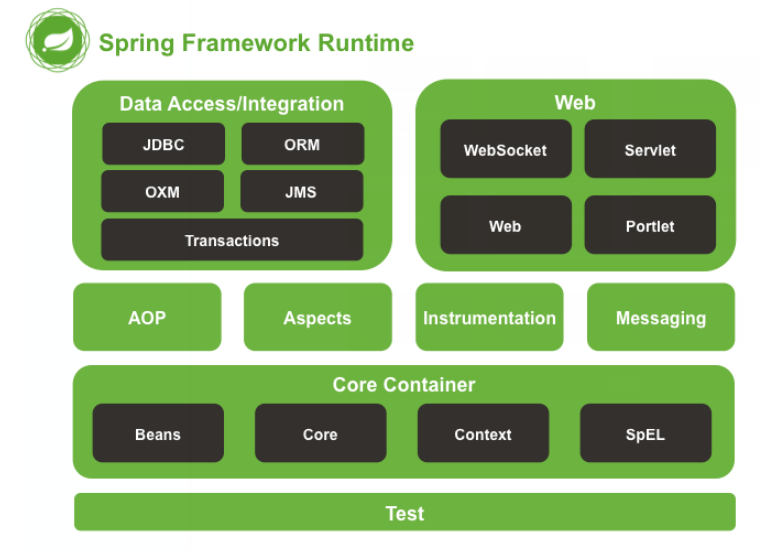
耦合
import java.sql.Connection;import java.sql.DriverManager;import java.sql.PreparedStatement;import java.sql.ResultSet;/*** 程序的耦合* 耦合:程序间的依赖关系* 包括:* 类之间的依赖* 方法间的依赖* 解耦:* 降低程序间的依赖关系* 实际开发中:* 应该做到:编译期不依赖,运行时才依赖。* 解耦的思路:* 第一步:使用反射来创建对象,而避免使用new关键字。* 第二步:通过读取配置文件来获取要创建的对象全限定类名**/public class JdbcDemo1 {public static void main(String[] args) throws Exception{//1.注册驱动// DriverManager.registerDriver(new com.mysql.jdbc.Driver());Class.forName("com.mysql.jdbc.Driver");//2.获取连接Connection conn = DriverManager.getConnection("jdbc:mysql://localhost:3306/eesy","root","1234");//3.获取操作数据库的预处理对象PreparedStatement pstm = conn.prepareStatement("select * from account");//4.执行SQL,得到结果集ResultSet rs = pstm.executeQuery();//5.遍历结果集while(rs.next()){System.out.println(rs.getString("name"));}//6.释放资源rs.close();pstm.close();conn.close();}}
工厂模式
在实际开发中我们可以把三层的对象都使用配置文件配置起来,当启动服务器应用加载的时候,让一个类中的
方法通过读取配置文件,把这些对象创建出来 并存起来。在接下来的使用的时候,直接拿过来用就好了。
那么,这个读取配置文件,创建和获取三层对象的类就是工厂。
读取配置,单例模式
//bean.propertiesaccountService=com.itheima.service.impl.AccountServiceImplaccountDao=com.itheima.dao.impl.AccountDaoImpl
package com.itheima.factory;
import java.io.InputStream;
import java.util.Enumeration;
import java.util.HashMap;
import java.util.Map;
import java.util.Properties;
/**
* 一个创建Bean对象的工厂
*
* Bean:在计算机英语中,有可重用组件的含义。
* JavaBean:用java语言编写的可重用组件。
* javabean > 实体类
*
* 它就是创建我们的service和dao对象的。
*
* 第一个:需要一个配置文件来配置我们的service和dao
* 配置的内容:唯一标识=全限定类名(key=value)
* 第二个:通过读取配置文件中配置的内容,反射创建对象
*
* 我的配置文件可以是xml也可以是properties
*/
public class BeanFactory {
//定义一个Properties对象
private static Properties props;
//定义一个Map,用于存放我们要创建的对象。我们把它称之为容器
private static Map<String,Object> beans;
//使用静态代码块为Properties对象赋值
static {
try {
//实例化对象
props = new Properties();
//获取properties文件的流对象
InputStream in = BeanFactory.class.getClassLoader().getResourceAsStream("bean.properties");
props.load(in);
//实例化容器
beans = new HashMap<String,Object>();
//取出配置文件中所有的Key
Enumeration keys = props.keys();
//遍历枚举
while (keys.hasMoreElements()){
//取出每个Key
String key = keys.nextElement().toString();
//根据key获取value
String beanPath = props.getProperty(key);
//反射创建对象
System.out.println("new");
Object value = Class.forName(beanPath).newInstance();
//把key和value存入容器中
beans.put(key,value);
}
}catch(Exception e){
throw new ExceptionInInitializerError("初始化properties失败!");
}
}
/**
* 根据bean的名称获取对象
* @param beanName
* @return
*/
public static Object getBean(String beanName){
return beans.get(beanName);
}
/**
* 根据Bean的名称获取bean对象
* @param beanName
* @return
public static Object getBean(String beanName){
Object bean = null;
try {
String beanPath = props.getProperty(beanName);
// System.out.println(beanPath);
bean = Class.forName(beanPath).newInstance();//每次都会调用默认构造函数创建对象
}catch (Exception e){
e.printStackTrace();
}
return bean;
}*/
}
/**
* 账户的业务层实现类
*/
public class AccountServiceImpl implements IAccountService {
// private IAccountDao accountDao = new AccountDaoImpl();
private IAccountDao accountDao = (IAccountDao)BeanFactory.getBean("accountDao");
// private int i = 1;
public void saveAccount(){
int i = 1;
accountDao.saveAccount();
System.out.println(i);
i++;
}
}
/**
* 模拟一个表现层,用于调用业务层
*/
public class Client {
public static void main(String[] args) {
//IAccountService as = new AccountServiceImpl();
for(int i=0;i<5;i++) {
IAccountService as = (IAccountService) BeanFactory.getBean("accountService");
System.out.println(as);
as.saveAccount();
}
}
}
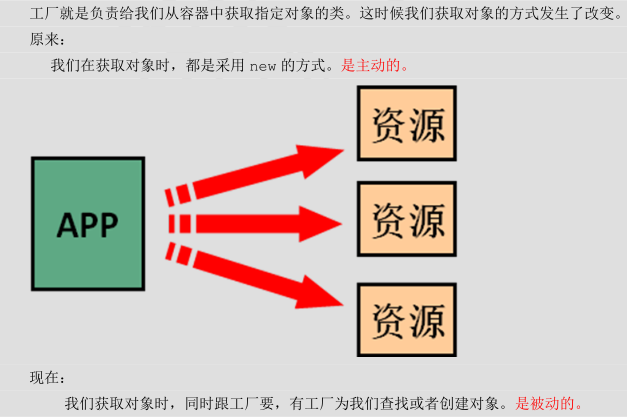

IOC
构建容器
<?xml version="1.0" encoding="UTF-8"?>
<project xmlns="http://maven.apache.org/POM/4.0.0"
xmlns:xsi="http://www.w3.org/2001/XMLSchema-instance"
xsi:schemaLocation="http://maven.apache.org/POM/4.0.0 http://maven.apache.org/xsd/maven-4.0.0.xsd">
<modelVersion>4.0.0</modelVersion>
<groupId>com.niliv</groupId>
<artifactId>day01_easy_jdbc</artifactId>
<version>1.0-SNAPSHOT</version>
<packaging>jar</packaging>
<dependencies>
<dependency>
<groupId>org.springframework</groupId>
<artifactId>spring-context</artifactId>
<version>5.0.2.RELEASE</version>
</dependency>
</dependencies>
</project>
import com.itheima.dao.IAccountDao;
import com.itheima.service.IAccountService;
import org.springframework.context.ApplicationContext;
import org.springframework.context.support.ClassPathXmlApplicationContext;
/**
* 模拟一个表现层,用于调用业务层
*/
public class Client {
/**
* 获取spring的Ioc核心容器,并根据id获取对象
*
* ApplicationContext的三个常用实现类:
* ClassPathXmlApplicationContext:它可以加载类路径下的配置文件,要求配置文件必须在类路径下。不在的话,加载不了。(更常用)
* FileSystemXmlApplicationContext:它可以加载磁盘任意路径下的配置文件(必须有访问权限)
*
* AnnotationConfigApplicationContext:它是用于读取注解创建容器的,是明天的内容。
*
* 核心容器的两个接口引发出的问题:
* ApplicationContext: 单例对象适用 采用此接口
* 它在构建核心容器时,创建对象采取的策略是采用立即加载的方式。也就是说,只要一读取完配置文件马上就创建配置文件中配置的对象。
*
* BeanFactory: 多例对象使用
* 它在构建核心容器时,创建对象采取的策略是采用延迟加载的方式。也就是说,什么时候根据id获取对象了,什么时候才真正的创建对象。
* @param args
*/
public static void main(String[] args) {
//1.获取核心容器对象
ApplicationContext ac = new ClassPathXmlApplicationContext("bean.xml");
// ApplicationContext ac = new FileSystemXmlApplicationContext("C:\\Users\\zhy\\Desktop\\bean.xml");
//2.根据id获取Bean对象
IAccountService as = (IAccountService)ac.getBean("accountService");
IAccountDao adao = ac.getBean("accountDao",IAccountDao.class);
System.out.println(as);
System.out.println(adao);
as.saveAccount();
//--------BeanFactory----------
// Resource resource = new ClassPathResource("bean.xml");
// BeanFactory factory = new XmlBeanFactory(resource);
// IAccountService as = (IAccountService)factory.getBean("accountService");
// System.out.println(as);
}
}
<?xml version="1.0" encoding="UTF-8"?>
<beans xmlns="http://www.springframework.org/schema/beans"
xmlns:xsi="http://www.w3.org/2001/XMLSchema-instance"
xsi:schemaLocation="http://www.springframework.org/schema/beans
http://www.springframework.org/schema/beans/spring-beans.xsd">
<!--把对象的创建交给spring来管理-->
<bean id="accountService" class="com.itheima.service.impl.AccountServiceImpl"></bean>
<bean id="accountDao" class="com.itheima.dao.impl.AccountDaoImpl"></bean>
</beans>
bean的创建方式 作用范围 生命周期
<?xml version="1.0" encoding="UTF-8"?>
<beans xmlns="http://www.springframework.org/schema/beans"
xmlns:xsi="http://www.w3.org/2001/XMLSchema-instance"
xsi:schemaLocation="http://www.springframework.org/schema/beans
http://www.springframework.org/schema/beans/spring-beans.xsd">
<!--把对象的创建交给spring来管理-->
<!--spring对bean的管理细节
1.创建bean的三种方式
2.bean对象的作用范围
3.bean对象的生命周期
-->
<!--创建Bean的三种方式 -->
<!-- 第一种方式:使用默认构造函数创建。
在spring的配置文件中使用bean标签,配以id和class属性之后,且没有其他属性和标签时。
采用的就是默认构造函数创建bean对象,此时如果类中没有默认构造函数,则对象无法创建。
<bean id="accountService" class="com.itheima.service.impl.AccountServiceImpl"></bean>
-->
<!-- 第二种方式: 使用普通工厂中的方法创建对象(使用某个类中的方法创建对象,并存入spring容器)
<bean id="instanceFactory" class="com.itheima.factory.InstanceFactory"></bean>
<bean id="accountService" factory-bean="instanceFactory" factory-method="getAccountService"></bean>
-->
<!-- 第三种方式:使用工厂中的静态方法创建对象(使用某个类中的静态方法创建对象,并存入spring容器)
<bean id="accountService" class="com.itheima.factory.StaticFactory" factory-method="getAccountService"></bean>
-->
<!-- bean的作用范围调整
bean标签的scope属性:
作用:用于指定bean的作用范围
取值: 常用的就是单例的和多例的
singleton:单例的(默认值)
prototype:多例的
request:作用于web应用的请求范围
session:作用于web应用的会话范围
global-session:作用于集群环境的会话范围(全局会话范围),当不是集群环境时,它就是session
<bean id="accountService" class="com.itheima.service.impl.AccountServiceImpl" scope="prototype"></bean>
-->
<!-- bean对象的生命周期
单例对象
出生:当容器创建时对象出生
活着:只要容器还在,对象一直活着
死亡:容器销毁,对象消亡
总结:单例对象的生命周期和容器相同
多例对象
出生:当我们使用对象时spring框架为我们创建
活着: 使用过程中活着
死亡:当对象长时间不用,且没有其他对象引用,java垃圾回收器回收
-->
<bean id="accountService" class="com.itheima.service.impl.AccountServiceImpl"
scope="singleton" init-method="init" destroy-method="destroy"></bean>
</beans>
/**
* 账户的业务层实现类
*/
public class AccountServiceImpl implements IAccountService {
public AccountServiceImpl(){
System.out.println("对象创建了");
}
public void saveAccount(){
System.out.println("service中的saveAccount方法执行了。。。");
}
public void init(){
System.out.println("对象初始化了。。。");
}
public void destroy(){
System.out.println("对象销毁了。。。");
}
}
/**
* 模拟一个工厂类(该类可能是存在于jar包中的,我们无法通过修改源码的方式来提供默认构造函数)
*/
public class InstanceFactory {
public IAccountService getAccountService(){
return new AccountServiceImpl();
}
}
/**
* 模拟一个工厂类(该类可能是存在于jar包中的,我们无法通过修改源码的方式来提供默认构造函数)
*/
public class StaticFactory {
public static IAccountService getAccountService(){
return new AccountServiceImpl();
}
}
Spring官方网站
Spring Boot
Spring Boot 参考入门项目
Spring 框架中文文档

jar包
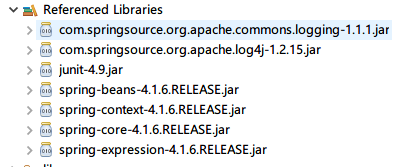
applicationContext.xml
<?xml version="1.0" encoding="UTF-8"?>
<beans xmlns="http://www.springframework.org/schema/beans"
xmlns:xsi="http://www.w3.org/2001/XMLSchema-instance"
xsi:schemaLocation="
http://www.springframework.org/schema/beans http://www.springframework.org/schema/beans/spring-beans.xsd">
<bean id="someServiceImpl" class="com.niliv.service.impl.SomeServiceImpl"></bean>
</beans>
测试类
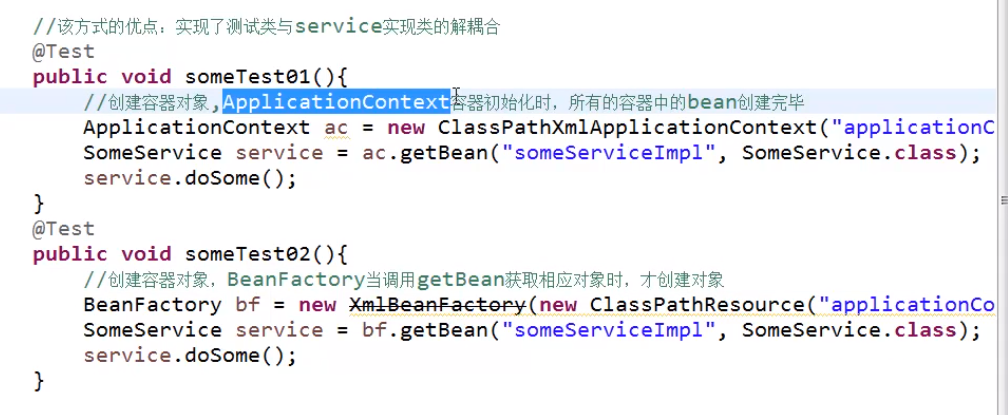
<?xml version="1.0" encoding="UTF-8"?>
<beans xmlns="http://www.springframework.org/schema/beans"
xmlns:xsi="http://www.w3.org/2001/XMLSchema-instance"
xsi:schemaLocation="
http://www.springframework.org/schema/beans http://www.springframework.org/schema/beans/spring-beans.xsd">
<!-- 构造函数创建bean
<bean id="someServiceImpl" class="com.niliv.service.impl.SomeServiceImpl"></bean>
-->
<!-- 动态注册工厂
<bean id="serviceFactory" class="com.niliv.factory.ServiceFactory"></bean>
-->
<!-- 从工厂中获取bean对象
<bean id="someServiceImpl" factory-bean="serviceFactory" factory-method="getSomeService"></bean>
-->
<!-- 静态工厂创建bean对象 -->
<bean id="someServiceImpl" class="com.niliv.factory.ServiceFactory" factory-method="getSomeServiceStatic"></bean>
</beans>
package com.niliv.factory;
import com.niliv.service.SomeService;
import com.niliv.service.impl.SomeServiceImpl;
public class ServiceFactory {
//实例工厂方式创建bean对象
public SomeService getSomeService() {
SomeService someServiceImpl = new SomeServiceImpl();
return someServiceImpl;
}
public static SomeService getSomeServiceStatic() {
SomeService someServiceImpl = new SomeServiceImpl();
return someServiceImpl;
}
}
bean默认是single模式
<bean id="someServiceImpl" class="com.niliv.service.impl.SomeServiceImpl"></bean>
<bean id="someServiceImpl1" class="com.niliv.service.impl.SomeServiceImpl"></bean>
ApplicationContext ac = new ClassPathXmlApplicationContext("applicationContext.xml");
SomeService service = ac.getBean("someServiceImpl", SomeService.class);
SomeService service0 = ac.getBean("someServiceImpl", SomeService.class);
SomeService service1 = ac.getBean("someServiceImpl1", SomeService.class);
System.out.println(service==service0);//true
System.out.println(service==service1);//false
也可以是prototype模式
<bean id="someServiceImpl" class="com.niliv.service.impl.SomeServiceImpl" scope="prototype"></bean>
<bean id="someServiceImpl1" class="com.niliv.service.impl.SomeServiceImpl" scope="prototype"></bean>
ApplicationContext ac = new ClassPathXmlApplicationContext("applicationContext.xml");
SomeService service = ac.getBean("someServiceImpl", SomeService.class);
SomeService service0 = ac.getBean("someServiceImpl", SomeService.class);
SomeService service1 = ac.getBean("someServiceImpl1", SomeService.class);
System.out.println(service==service0);//false
System.out.println(service==service1);//false
DI
配置方式
<?xml version="1.0" encoding="UTF-8"?>
<beans xmlns="http://www.springframework.org/schema/beans"
xmlns:xsi="http://www.w3.org/2001/XMLSchema-instance"
xsi:schemaLocation="http://www.springframework.org/schema/beans
http://www.springframework.org/schema/beans/spring-beans.xsd">
<!-- spring中的依赖注入
依赖注入:
Dependency Injection
IOC的作用:
降低程序间的耦合(依赖关系)
依赖关系的管理:
以后都交给spring来维护
在当前类需要用到其他类的对象,由spring为我们提供,我们只需要在配置文件中说明
依赖关系的维护:
就称之为依赖注入。
依赖注入:
能注入的数据:有三类
基本类型和String
其他bean类型(在配置文件中或者注解配置过的bean)
复杂类型/集合类型
注入的方式:有三种
第一种:使用构造函数提供
第二种:使用set方法提供
第三种:使用注解提供(明天的内容)
-->
<!--构造函数注入:
使用的标签:constructor-arg
标签出现的位置:bean标签的内部
标签中的属性
type:用于指定要注入的数据的数据类型,该数据类型也是构造函数中某个或某些参数的类型
index:用于指定要注入的数据给构造函数中指定索引位置的参数赋值。索引的位置是从0开始
name:用于指定给构造函数中指定名称的参数赋值 常用的
=============以上三个用于指定给构造函数中哪个参数赋值===============================
value:用于提供基本类型和String类型的数据
ref:用于指定其他的bean类型数据。它指的就是在spring的Ioc核心容器中出现过的bean对象
优势:
在获取bean对象时,注入数据是必须的操作,否则对象无法创建成功。
弊端:
改变了bean对象的实例化方式,使我们在创建对象时,如果用不到这些数据,也必须提供。
-->
<bean id="accountService" class="com.itheima.service.impl.AccountServiceImpl">
<constructor-arg name="name" value="泰斯特"></constructor-arg>
<constructor-arg name="age" value="18"></constructor-arg>
<constructor-arg name="birthday" ref="now"></constructor-arg>
</bean>
<!-- 配置一个日期对象 -->
<bean id="now" class="java.util.Date"></bean>
<!-- set方法注入 更常用的方式
涉及的标签:property
出现的位置:bean标签的内部
标签的属性
name:用于指定注入时所调用的set方法名称 去掉set小写
value:用于提供基本类型和String类型的数据
ref:用于指定其他的bean类型数据。它指的就是在spring的Ioc核心容器中出现过的bean对象
优势:
创建对象时没有明确的限制,可以直接使用默认构造函数
弊端:
如果有某个成员必须有值,则获取对象是有可能set方法没有执行。
-->
<bean id="accountService2" class="com.itheima.service.impl.AccountServiceImpl2">
<property name="name" value="TEST" ></property>
<property name="age" value="21"></property>
<property name="birthday" ref="now"></property>
</bean>
<!-- 复杂类型的注入/集合类型的注入 -->
<bean id="accountService3" class="com.itheima.service.impl.AccountServiceImpl3">
<property name="myStrs">
<set>
<value>AAA</value>
<value>BBB</value>
<value>CCC</value>
</set>
</property>
<property name="myList">
<array>
<value>AAA</value>
<value>BBB</value>
<value>CCC</value>
</array>
</property>
<property name="mySet">
<list>
<value>AAA</value>
<value>BBB</value>
<value>CCC</value>
</list>
</property>
<property name="myMap">
<props>
<prop key="testC">ccc</prop>
<prop key="testD">ddd</prop>
</props>
</property>
<property name="myProps">
<map>
<entry key="testA" value="aaa"></entry>
<entry key="testB">
<value>BBB</value>
</entry>
</map>
</property>
</bean>
</beans>
/**
* 账户的业务层实现类
*/
public class AccountServiceImpl implements IAccountService {
//如果是经常变化的数据,并不适用于注入的方式
private String name;
private Integer age;
private Date birthday;
public AccountServiceImpl(String name,Integer age,Date birthday){
this.name = name;
this.age = age;
this.birthday = birthday;
}
public void saveAccount(){
System.out.println("service中的saveAccount方法执行了。。。"+name+","+age+","+birthday);
}
}
/**
* 账户的业务层实现类
*/
public class AccountServiceImpl2 implements IAccountService {
//如果是经常变化的数据,并不适用于注入的方式
private String name;
private Integer age;
private Date birthday;
public void setName(String name) {
this.name = name;
}
public void setAge(Integer age) {
this.age = age;
}
public void setBirthday(Date birthday) {
this.birthday = birthday;
}
public void saveAccount(){
System.out.println("service中的saveAccount方法执行了。。。"+name+","+age+","+birthday);
}
}
/**
* 账户的业务层实现类
*/
public class AccountServiceImpl3 implements IAccountService {
private String[] myStrs;
private List<String> myList;
private Set<String> mySet;
private Map<String,String> myMap;
private Properties myProps;
public void setMyStrs(String[] myStrs) {
this.myStrs = myStrs;
}
public void setMyList(List<String> myList) {
this.myList = myList;
}
public void setMySet(Set<String> mySet) {
this.mySet = mySet;
}
public void setMyMap(Map<String, String> myMap) {
this.myMap = myMap;
}
public void setMyProps(Properties myProps) {
this.myProps = myProps;
}
public void saveAccount(){
System.out.println(Arrays.toString(myStrs));
System.out.println(myList);
System.out.println(mySet);
System.out.println(myMap);
System.out.println(myProps);
}
}
public static void main(String[] args) {
//1.获取核心容器对象
ApplicationContext ac = new ClassPathXmlApplicationContext("bean.xml");
//2.根据id获取Bean对象
// IAccountService as = (IAccountService)ac.getBean("accountService");
// as.saveAccount();
// IAccountService as = (IAccountService)ac.getBean("accountService2");
// as.saveAccount();
IAccountService as = (IAccountService)ac.getBean("accountService3");
as.saveAccount();
}
}
注解方式 创建bean 注入bean和其他
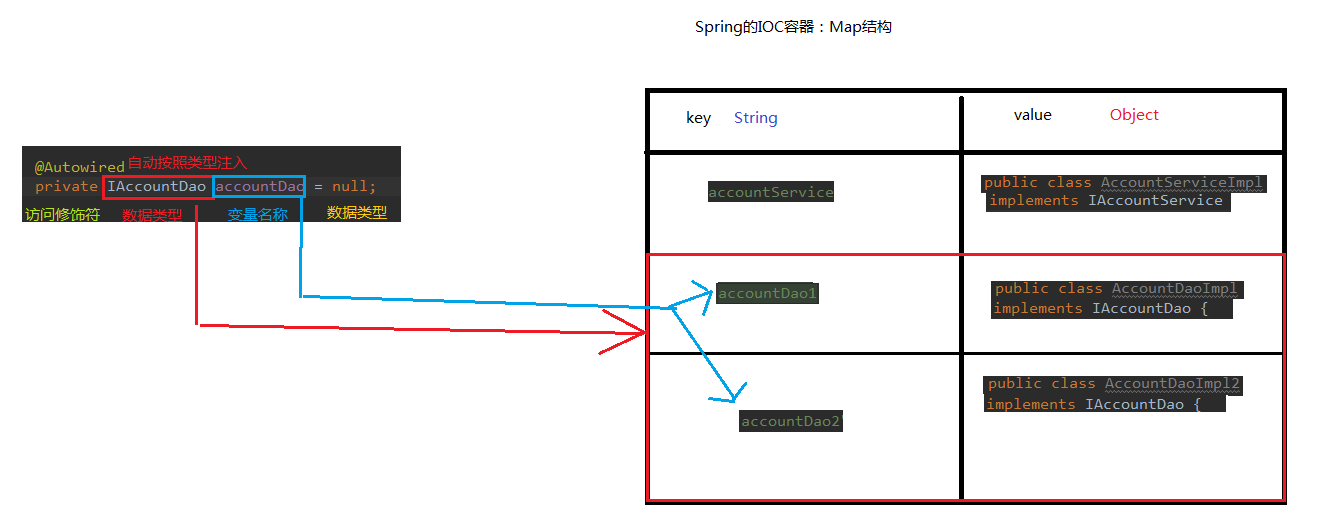
<?xml version="1.0" encoding="UTF-8"?>
<beans xmlns="http://www.springframework.org/schema/beans"
xmlns:xsi="http://www.w3.org/2001/XMLSchema-instance"
xmlns:context="http://www.springframework.org/schema/context"
xsi:schemaLocation="http://www.springframework.org/schema/beans
http://www.springframework.org/schema/beans/spring-beans.xsd
http://www.springframework.org/schema/context
http://www.springframework.org/schema/context/spring-context.xsd">
<!--告知spring在创建容器时要扫描的包,配置所需要的标签不是在beans的约束中,而是一个名称为
context名称空间和约束中-->
<context:component-scan base-package="com.itheima"></context:component-scan>
</beans>
package com.itheima.service.impl;
import com.itheima.dao.IAccountDao;
import com.itheima.service.IAccountService;
import org.springframework.stereotype.Service;
import javax.annotation.PostConstruct;
import javax.annotation.PreDestroy;
import javax.annotation.Resource;
/**
* 账户的业务层实现类
*
* 曾经XML的配置:
* <bean id="accountService" class="com.itheima.service.impl.AccountServiceImpl"
* scope="" init-method="" destroy-method="">
* <property name="" value="" | ref=""></property>
* </bean>
*
* 用于创建对象的
* 他们的作用就和在XML配置文件中编写一个<bean>标签实现的功能是一样的
* Component:
* 作用:用于把当前类对象存入spring容器中
* 属性:
* value:用于指定bean的id。当我们不写时,它的默认值是当前类名,且首字母改小写。
* Controller:一般用在表现层
* Service:一般用在业务层
* Repository:一般用在持久层
* 以上三个注解他们的作用和属性与Component是一模一样。
* 他们三个是spring框架为我们提供明确的三层使用的注解,使我们的三层对象更加清晰
*
*
* 用于注入数据的
* 他们的作用就和在xml配置文件中的bean标签中写一个<property>标签的作用是一样的
* Autowired:
* 作用:自动按照类型注入。只要容器中有唯一的一个bean对象类型和要注入的变量类型匹配,就可以注入成功
* 如果ioc容器中没有任何bean的类型和要注入的变量类型匹配,则报错。
* 如果Ioc容器中有多个类型匹配时:
* 出现位置:
* 可以是变量上,也可以是方法上
* 细节:
* 在使用注解注入时,set方法就不是必须的了。
* Qualifier:
* 作用:在按照类中注入的基础之上再按照名称注入。它在给类成员注入时不能单独使用。但是在给方法参数注入时可以(稍后我们讲)
* 属性:
* value:用于指定注入bean的id。
* Resource
* 作用:直接按照bean的id注入。它可以独立使用
* 属性:
* name:用于指定bean的id。
* 以上三个注入都只能注入其他bean类型的数据,而基本类型和String类型无法使用上述注解实现。
* 另外,集合类型的注入只能通过XML来实现。
*
* Value
* 作用:用于注入基本类型和String类型的数据
* 属性:
* value:用于指定数据的值。它可以使用spring中SpEL(也就是spring的el表达式)
* SpEL的写法:${表达式}
*
* 用于改变作用范围的
* 他们的作用就和在bean标签中使用scope属性实现的功能是一样的
* Scope
* 作用:用于指定bean的作用范围
* 属性:
* value:指定范围的取值。常用取值:singleton prototype
*
* 和生命周期相关 了解
* 他们的作用就和在bean标签中使用init-method和destroy-methode的作用是一样的
* PreDestroy
* 作用:用于指定销毁方法
* PostConstruct
* 作用:用于指定初始化方法
*/
@Service("accountService")
//@Scope("prototype")
public class AccountServiceImpl implements IAccountService {
// @Autowired
// @Qualifier("accountDao1")
@Resource(name = "accountDao2")
private IAccountDao accountDao = null;
@PostConstruct
public void init(){
System.out.println("初始化方法执行了");
}
@PreDestroy
public void destroy(){
System.out.println("销毁方法执行了");
}
public void saveAccount(){
accountDao.saveAccount();
}
}
/**
* 账户的持久层实现类
*/
@Repository("accountDao1")
public class AccountDaoImpl implements IAccountDao
{
public void saveAccount(){
System.out.println("保存了账户1111111111111");
}
}
/**
* 账户的持久层实现类
*/
@Repository("accountDao2")
public class AccountDaoImpl2 implements IAccountDao {
public void saveAccount(){
System.out.println("保存了账户2222222222222");
}
}
public static void main(String[] args) {
//1.获取核心容器对象
// ApplicationContext ac = new ClassPathXmlApplicationContext("bean.xml");
ClassPathXmlApplicationContext ac = new ClassPathXmlApplicationContext("bean.xml");
//2.根据id获取Bean对象
IAccountService as = (IAccountService)ac.getBean("accountService");
// IAccountService as2 = (IAccountService)ac.getBean("accountService");
// System.out.println(as);
// IAccountDao adao = ac.getBean("accountDao",IAccountDao.class);
// System.out.println(adao);
// System.out.println(as == as2);
as.saveAccount();
ac.close();
}
IOC DI 案例
基于配置的案例
package com.itheima.domain;
import java.io.Serializable;
/**
* 账户的实体类
*/
public class Account implements Serializable {
private Integer id;
private String name;
private Float money;
public Integer getId() {
return id;
}
public void setId(Integer id) {
this.id = id;
}
public String getName() {
return name;
}
public void setName(String name) {
this.name = name;
}
public Float getMoney() {
return money;
}
public void setMoney(Float money) {
this.money = money;
}
@Override
public String toString() {
return "Account{" +
"id=" + id +
", name='" + name + '\'' +
", money=" + money +
'}';
}
}
package com.itheima.dao.impl;
import com.itheima.dao.IAccountDao;
import com.itheima.domain.Account;
import org.apache.commons.dbutils.QueryRunner;
import org.apache.commons.dbutils.handlers.BeanHandler;
import org.apache.commons.dbutils.handlers.BeanListHandler;
import java.util.List;
/**
* 账户的持久层实现类
*/
public class AccountDaoImpl implements IAccountDao {
private QueryRunner runner;
public void setRunner(QueryRunner runner) {
this.runner = runner;
}
@Override
public List<Account> findAllAccount() {
try{
return runner.query("select * from account",new BeanListHandler<Account>(Account.class));
}catch (Exception e) {
throw new RuntimeException(e);
}
}
@Override
public Account findAccountById(Integer accountId) {
try{
return runner.query("select * from account where id = ? ",new BeanHandler<Account>(Account.class),accountId);
}catch (Exception e) {
throw new RuntimeException(e);
}
}
@Override
public void saveAccount(Account account) {
try{
runner.update("insert into account(name,money)values(?,?)",account.getName(),account.getMoney());
}catch (Exception e) {
throw new RuntimeException(e);
}
}
@Override
public void updateAccount(Account account) {
try{
runner.update("update account set name=?,money=? where id=?",account.getName(),account.getMoney(),account.getId());
}catch (Exception e) {
throw new RuntimeException(e);
}
}
@Override
public void deleteAccount(Integer accountId) {
try{
runner.update("delete from account where id=?",accountId);
}catch (Exception e) {
throw new RuntimeException(e);
}
}
}
package com.itheima.service.impl;
import com.itheima.dao.IAccountDao;
import com.itheima.domain.Account;
import com.itheima.service.IAccountService;
import java.util.List;
/**
* 账户的业务层实现类
*/
public class AccountServiceImpl implements IAccountService{
private IAccountDao accountDao;
public void setAccountDao(IAccountDao accountDao) {
this.accountDao = accountDao;
}
@Override
public List<Account> findAllAccount() {
return accountDao.findAllAccount();
}
@Override
public Account findAccountById(Integer accountId) {
return accountDao.findAccountById(accountId);
}
@Override
public void saveAccount(Account account) {
accountDao.saveAccount(account);
}
@Override
public void updateAccount(Account account) {
accountDao.updateAccount(account);
}
@Override
public void deleteAccount(Integer acccountId) {
accountDao.deleteAccount(acccountId);
}
}
// bean.xml
<?xml version="1.0" encoding="UTF-8"?>
<beans xmlns="http://www.springframework.org/schema/beans"
xmlns:xsi="http://www.w3.org/2001/XMLSchema-instance"
xsi:schemaLocation="http://www.springframework.org/schema/beans
http://www.springframework.org/schema/beans/spring-beans.xsd">
<!-- 配置Service -->
<bean id="accountService" class="com.itheima.service.impl.AccountServiceImpl">
<!-- 注入dao -->
<property name="accountDao" ref="accountDao"></property>
</bean>
<!--配置Dao对象-->
<bean id="accountDao" class="com.itheima.dao.impl.AccountDaoImpl">
<!-- 注入QueryRunner -->
<property name="runner" ref="runner"></property>
</bean>
<!--配置QueryRunner-->
<bean id="runner" class="org.apache.commons.dbutils.QueryRunner" scope="prototype">
<!--注入数据源-->
<constructor-arg name="ds" ref="dataSource"></constructor-arg>
</bean>
<!-- 配置数据源 -->
<bean id="dataSource" class="com.mchange.v2.c3p0.ComboPooledDataSource">
<!--连接数据库的必备信息-->
<property name="driverClass" value="com.mysql.jdbc.Driver"></property>
<property name="jdbcUrl" value="jdbc:mysql://118.24.175.34:3306/java_test"></property>
<property name="user" value="root"></property>
<property name="password" value="1234"></property>
</bean>
</beans>
//pom.xml
<?xml version="1.0" encoding="UTF-8"?>
<project xmlns="http://maven.apache.org/POM/4.0.0"
xmlns:xsi="http://www.w3.org/2001/XMLSchema-instance"
xsi:schemaLocation="http://maven.apache.org/POM/4.0.0 http://maven.apache.org/xsd/maven-4.0.0.xsd">
<modelVersion>4.0.0</modelVersion>
<groupId>com.itheima</groupId>
<artifactId>day02_xmlioc</artifactId>
<version>1.0-SNAPSHOT</version>
<packaging>jar</packaging>
<dependencies>
<dependency>
<groupId>org.springframework</groupId>
<artifactId>spring-context</artifactId>
<version>5.0.2.RELEASE</version>
</dependency>
<dependency>
<groupId>org.springframework</groupId>
<artifactId>spring-test</artifactId>
<version>LATEST</version>
<scope>test</scope>
</dependency>
<dependency>
<groupId>commons-dbutils</groupId>
<artifactId>commons-dbutils</artifactId>
<version>1.4</version>
</dependency>
<dependency>
<groupId>mysql</groupId>
<artifactId>mysql-connector-java</artifactId>
<version>5.1.6</version>
</dependency>
<dependency>
<groupId>c3p0</groupId>
<artifactId>c3p0</artifactId>
<version>0.9.1.2</version>
</dependency>
<dependency>
<groupId>junit</groupId>
<artifactId>junit</artifactId>
<version>4.12</version>
</dependency>
</dependencies>
</project>
import com.itheima.domain.Account;
import com.itheima.service.IAccountService;
import org.junit.Test;
import org.junit.runner.RunWith;
import org.springframework.beans.factory.annotation.Autowired;
import org.springframework.test.context.ContextConfiguration;
import org.springframework.test.context.junit4.SpringJUnit4ClassRunner;
import java.util.List;
/**
* 使用Junit单元测试:测试我们的配置
*/
@RunWith(SpringJUnit4ClassRunner.class)
@ContextConfiguration(locations = "classpath:bean.xml")
public class AccountServiceTest {
@Autowired
private IAccountService as;
@Test
public void testFindAll() {
//3.执行方法
List<Account> accounts = as.findAllAccount();
for(Account account : accounts){
System.out.println(account);
}
}
@Test
public void testFindOne() {
//3.执行方法
Account account = as.findAccountById(1);
System.out.println(account);
}
@Test
public void testSave() {
Account account = new Account();
account.setName("test");
account.setMoney(12345f);
//3.执行方法
as.saveAccount(account);
}
@Test
public void testUpdate() {
//3.执行方法
Account account = as.findAccountById(4);
account.setMoney(23456f);
as.updateAccount(account);
}
@Test
public void testDelete() {
//3.执行方法
as.deleteAccount(4);
}
}
基于注解的案例
import com.itheima.dao.IAccountDao;
import com.itheima.domain.Account;
import com.itheima.service.IAccountService;
import org.springframework.beans.factory.annotation.Autowired;
import org.springframework.stereotype.Service;
import java.util.List;
/**
* 账户的业务层实现类
*/
@Service("accountService")
public class AccountServiceImpl implements IAccountService{
@Autowired
private IAccountDao accountDao;
@Override
public List<Account> findAllAccount() {
return accountDao.findAllAccount();
}
@Override
public Account findAccountById(Integer accountId) {
return accountDao.findAccountById(accountId);
}
@Override
public void saveAccount(Account account) {
accountDao.saveAccount(account);
}
@Override
public void updateAccount(Account account) {
accountDao.updateAccount(account);
}
@Override
public void deleteAccount(Integer acccountId) {
accountDao.deleteAccount(acccountId);
}
}
import com.itheima.dao.IAccountDao;
import com.itheima.domain.Account;
import org.apache.commons.dbutils.QueryRunner;
import org.apache.commons.dbutils.handlers.BeanHandler;
import org.apache.commons.dbutils.handlers.BeanListHandler;
import org.springframework.beans.factory.annotation.Autowired;
import org.springframework.stereotype.Repository;
import java.util.List;
/**
* 账户的持久层实现类
*/
@Repository("accountDao")
public class AccountDaoImpl implements IAccountDao {
@Autowired
private QueryRunner runner;
@Override
public List<Account> findAllAccount() {
try{
return runner.query("select * from account",new BeanListHandler<Account>(Account.class));
}catch (Exception e) {
throw new RuntimeException(e);
}
}
@Override
public Account findAccountById(Integer accountId) {
try{
return runner.query("select * from account where id = ? ",new BeanHandler<Account>(Account.class),accountId);
}catch (Exception e) {
throw new RuntimeException(e);
}
}
@Override
public void saveAccount(Account account) {
try{
runner.update("insert into account(name,money)values(?,?)",account.getName(),account.getMoney());
}catch (Exception e) {
throw new RuntimeException(e);
}
}
@Override
public void updateAccount(Account account) {
try{
runner.update("update account set name=?,money=? where id=?",account.getName(),account.getMoney(),account.getId());
}catch (Exception e) {
throw new RuntimeException(e);
}
}
@Override
public void deleteAccount(Integer accountId) {
try{
runner.update("delete from account where id=?",accountId);
}catch (Exception e) {
throw new RuntimeException(e);
}
}
}
<?xml version="1.0" encoding="UTF-8"?>
<beans xmlns="http://www.springframework.org/schema/beans"
xmlns:xsi="http://www.w3.org/2001/XMLSchema-instance"
xmlns:context="http://www.springframework.org/schema/context"
xsi:schemaLocation="http://www.springframework.org/schema/beans
http://www.springframework.org/schema/beans/spring-beans.xsd
http://www.springframework.org/schema/context
http://www.springframework.org/schema/context/spring-context.xsd">
<!-- 告知spring在创建容器时要扫描的包 -->
<context:component-scan base-package="com.itheima"></context:component-scan>
<!--配置QueryRunner-->
<bean id="runner" class="org.apache.commons.dbutils.QueryRunner" scope="prototype">
<!--注入数据源-->
<constructor-arg name="ds" ref="dataSource"></constructor-arg>
</bean>
<!-- 配置数据源 -->
<bean id="dataSource" class="com.mchange.v2.c3p0.ComboPooledDataSource">
<!--连接数据库的必备信息-->
<property name="driverClass" value="com.mysql.jdbc.Driver"></property>
<property name="jdbcUrl" value="jdbc:mysql://localhost:3306/eesy"></property>
<property name="user" value="root"></property>
<property name="password" value="1234"></property>
</bean>
</beans>
基于纯注解的案例
import com.itheima.dao.IAccountDao;
import com.itheima.domain.Account;
import org.apache.commons.dbutils.QueryRunner;
import org.apache.commons.dbutils.handlers.BeanHandler;
import org.apache.commons.dbutils.handlers.BeanListHandler;
import org.springframework.beans.factory.annotation.Autowired;
import org.springframework.stereotype.Repository;
import java.util.List;
/**
* 账户的持久层实现类
*/
@Repository("accountDao")
public class AccountDaoImpl implements IAccountDao {
@Autowired
private QueryRunner runner;
@Override
public List<Account> findAllAccount() {
try{
return runner.query("select * from account",new BeanListHandler<Account>(Account.class));
}catch (Exception e) {
throw new RuntimeException(e);
}
}
@Override
public Account findAccountById(Integer accountId) {
try{
return runner.query("select * from account where id = ? ",new BeanHandler<Account>(Account.class),accountId);
}catch (Exception e) {
throw new RuntimeException(e);
}
}
@Override
public void saveAccount(Account account) {
try{
runner.update("insert into account(name,money)values(?,?)",account.getName(),account.getMoney());
}catch (Exception e) {
throw new RuntimeException(e);
}
}
@Override
public void updateAccount(Account account) {
try{
runner.update("update account set name=?,money=? where id=?",account.getName(),account.getMoney(),account.getId());
}catch (Exception e) {
throw new RuntimeException(e);
}
}
@Override
public void deleteAccount(Integer accountId) {
try{
runner.update("delete from account where id=?",accountId);
}catch (Exception e) {
throw new RuntimeException(e);
}
}
}
/**
* 账户的业务层实现类
*/
@Service("accountService")
public class AccountServiceImpl implements IAccountService{
@Autowired
private IAccountDao accountDao;
@Override
public List<Account> findAllAccount() {
return accountDao.findAllAccount();
}
@Override
public Account findAccountById(Integer accountId) {
return accountDao.findAccountById(accountId);
}
@Override
public void saveAccount(Account account) {
accountDao.saveAccount(account);
}
@Override
public void updateAccount(Account account) {
accountDao.updateAccount(account);
}
@Override
public void deleteAccount(Integer acccountId) {
accountDao.deleteAccount(acccountId);
}
}
package config;
import org.springframework.context.annotation.ComponentScan;
import org.springframework.context.annotation.Import;
import org.springframework.context.annotation.PropertySource;
/**
* 该类是一个配置类,它的作用和bean.xml是一样的
* spring中的新注解
* Configuration
* 作用:指定当前类是一个配置类
* 细节:当配置类作为AnnotationConfigApplicationContext对象创建的参数时,该注解可以不写。
* ComponentScan
* 作用:用于通过注解指定spring在创建容器时要扫描的包
* 属性:
* value:它和basePackages的作用是一样的,都是用于指定创建容器时要扫描的包。
* 我们使用此注解就等同于在xml中配置了:
* <context:component-scan base-package="com.itheima"></context:component-scan>
* Bean
* 作用:用于把当前方法的返回值作为bean对象存入spring的ioc容器中
* 属性:
* name:用于指定bean的id。当不写时,默认值是当前方法的名称
* 细节:
* 当我们使用注解配置方法时,如果方法有参数,spring框架会去容器中查找有没有可用的bean对象。
* 查找的方式和Autowired注解的作用是一样的
* Import
* 作用:用于导入其他的配置类
* 属性:
* value:用于指定其他配置类的字节码。
* 当我们使用Import的注解之后,有Import注解的类就父配置类,而导入的都是子配置类
* PropertySource
* 作用:用于指定properties文件的位置
* 属性:
* value:指定文件的名称和路径。
* 关键字:classpath,表示类路径下
*/
//@Configuration
@ComponentScan("com.itheima")
@Import(JdbcConfig.class)
@PropertySource("classpath:jdbcConfig.properties")
public class SpringConfiguration {
}
package config;
import com.mchange.v2.c3p0.ComboPooledDataSource;
import org.apache.commons.dbutils.QueryRunner;
import org.springframework.beans.factory.annotation.Qualifier;
import org.springframework.beans.factory.annotation.Value;
import org.springframework.context.annotation.Bean;
import org.springframework.context.annotation.Scope;
import javax.sql.DataSource;
/**
* 和spring连接数据库相关的配置类
*/
public class JdbcConfig {
@Value("${jdbc.driver}")
private String driver;
@Value("${jdbc.url}")
private String url;
@Value("${jdbc.username}")
private String username;
@Value("${jdbc.password}")
private String password;
/**
* 用于创建一个QueryRunner对象
* @param dataSource
* @return
*/
@Bean(name="runner")
@Scope("prototype")
public QueryRunner createQueryRunner(@Qualifier("ds2") DataSource dataSource){
return new QueryRunner(dataSource);
}
/**
* 创建数据源对象
* @return
*/
@Bean(name="ds2")
public DataSource createDataSource(){
try {
ComboPooledDataSource ds = new ComboPooledDataSource();
ds.setDriverClass(driver);
ds.setJdbcUrl(url);
ds.setUser(username);
ds.setPassword(password);
return ds;
}catch (Exception e){
throw new RuntimeException(e);
}
}
@Bean(name="ds1")
public DataSource createDataSource1(){
try {
ComboPooledDataSource ds = new ComboPooledDataSource();
ds.setDriverClass(driver);
ds.setJdbcUrl("jdbc:mysql://118.24.175.34:3306/java_test");
ds.setUser(username);
ds.setPassword(password);
return ds;
}catch (Exception e){
throw new RuntimeException(e);
}
}
}
jdbc.driver=com.mysql.jdbc.Driver
jdbc.url=jdbc:mysql://118.24.175.34:3306/java_test
jdbc.username=root
jdbc.password=p@ssw0rd
package com.itheima.test;
import com.itheima.domain.Account;
import com.itheima.service.IAccountService;
import config.SpringConfiguration;
import org.junit.Test;
import org.junit.runner.RunWith;
import org.springframework.beans.factory.annotation.Autowired;
import org.springframework.test.context.ContextConfiguration;
import org.springframework.test.context.junit4.SpringJUnit4ClassRunner;
import java.util.List;
/**
* 1、应用程序的入口
* main方法
* 2、junit单元测试中,没有main方法也能执行
* junit集成了一个main方法
* 该方法就会判断当前测试类中哪些方法有 @Test注解
* junit就让有Test注解的方法执行
* 3、junit不会管我们是否采用spring框架
* 在执行测试方法时,junit根本不知道我们是不是使用了spring框架
* 所以也就不会为我们读取配置文件/配置类创建spring核心容器
* 4、由以上三点可知
* 当测试方法执行时,没有Ioc容器,就算写了Autowired注解,也无法实现注入
*
* 使用Junit单元测试:测试我们的配置
* Spring整合junit的配置
* 1、导入spring整合junit的jar(坐标)
* 2、使用Junit提供的一个注解把原有的main方法替换了,替换成spring提供的
* @Runwith
* 3、告知spring的运行器,spring和ioc创建是基于xml还是注解的,并且说明位置
* @ContextConfiguration
* locations:指定xml文件的位置,加上classpath关键字,表示在类路径下
* classes:指定注解类所在地位置
*
* 当我们使用spring 5.x版本的时候,要求junit的jar必须是4.12及以上
*/
@RunWith(SpringJUnit4ClassRunner.class)
@ContextConfiguration(classes = SpringConfiguration.class)
public class AccountServiceTest {
@Autowired
private IAccountService as = null;
@Test
public void testFindAll() {
//3.执行方法
List<Account> accounts = as.findAllAccount();
for(Account account : accounts){
System.out.println(account);
}
}
@Test
public void testFindOne() {
//3.执行方法
Account account = as.findAccountById(1);
System.out.println(account);
}
@Test
public void testSave() {
Account account = new Account();
account.setName("test anno");
account.setMoney(12345f);
//3.执行方法
as.saveAccount(account);
}
@Test
public void testUpdate() {
//3.执行方法
Account account = as.findAccountById(4);
account.setMoney(23456f);
as.updateAccount(account);
}
@Test
public void testDelete() {
//3.执行方法
as.deleteAccount(4);
}
}
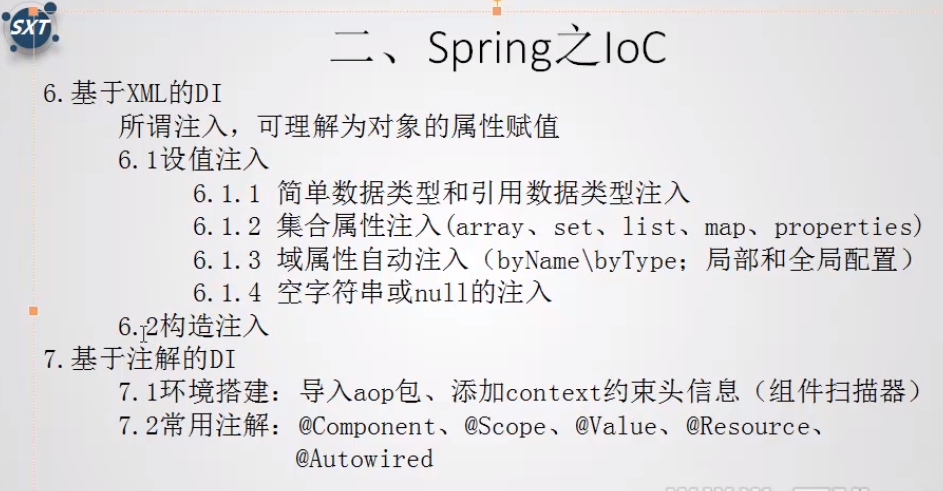
值DI
<!-- 设值方式DI -->
<bean id="star" class="com.niliv.pojo.Star" >
<property name="name" value="贝克汉姆"></property>
<property name="age" value="39"></property>
<property name="partner" ref="partner"></property>
</bean>
<bean id="partner" class="com.niliv.pojo.Partner" >
<property name="name" value="维多利亚"></property>
</bean>
@Test
public void someTest01() {
ApplicationContext ac = new ClassPathXmlApplicationContext("applicationContext.xml");
Star star = ac.getBean("star",Star.class);
System.out.println(star);
}
集合属性注入
public class DiService {
private String[] myArray;
private Set<Partner> mySet;
private List<String> myList;
private Map<String, String> myMap;
private Properties myProps;
public String[] getMyArray() {
return myArray;
}
public void setMyArray(String[] myArray) {
this.myArray = myArray;
}
public Set<Partner> getMySet() {
return mySet;
}
public void setMySet(Set<Partner> mySet) {
this.mySet = mySet;
}
public List<String> getMyList() {
return myList;
}
public void setMyList(List<String> myList) {
this.myList = myList;
}
public Map<String, String> getMyMap() {
return myMap;
}
public void setMyMap(Map<String, String> myMap) {
this.myMap = myMap;
}
public Properties getMyProps() {
return myProps;
}
public void setMyProps(Properties myProps) {
this.myProps = myProps;
}
@Override
public String toString() {
return "DiService [myArray=" + Arrays.toString(myArray) + ", mySet=" + mySet + ", myList=" + myList + ", myMap="
+ myMap + ", myProps=" + myProps + "]";
}
}
<bean id="diService" class="com.niliv.service.DiService" >
<property name="myArray">
<array>
<value>北京</value>
<value>上海</value>
</array>
</property>
<property name="mySet">
<set>
<ref bean="partner1"/>
<ref bean="partner2"/>
</set>
</property>
<property name="myList">
<list>
<value>男</value>
<value>女</value>
</list>
</property>
<property name="myMap">
<map>
<entry key="qq" value="123456"></entry>
<entry key="mobile" value="1330000000"></entry>
</map>
</property>
<property name="myProps">
<props>
<prop key="兴趣">足球</prop>
<prop key="爱好">下期</prop>
</props>
</property>
</bean>
域属性的自动注入


全局设置

空和null

构造DI
<!-- 构造函数注入
<bean id="star1" class="com.niliv.pojo.Star">
<constructor-arg name="name" value="aa"></constructor-arg>
<constructor-arg name="age" value="11"></constructor-arg>
<constructor-arg name="partner" ref="partner"></constructor-arg>
</bean>-->
<!-- 构造函数注入 index
<bean id="star1" class="com.niliv.pojo.Star">
<constructor-arg index="0" value="aa"></constructor-arg>
<constructor-arg index="1" value="11"></constructor-arg>
<constructor-arg index="2" ref="partner"></constructor-arg>
</bean>
-->
<!-- 构造函数注入 按顺序-->
<bean id="star1" class="com.niliv.pojo.Star">
<constructor-arg value="aa"></constructor-arg>
<constructor-arg value="11"></constructor-arg>
<constructor-arg ref="partner"></constructor-arg>
</bean>
<bean id="partner" class="com.niliv.pojo.Partner" >
<property name="name" value="维多利亚"></property>
</bean>
public class Star {
private String name;
private int age;
private Partner partner;
public Star(String name, int age, Partner partner) {
super();
this.name = name;
this.age = age;
this.partner = partner;
}
public Star() {
super();
}
public Partner getPartner() {
return partner;
}
public void setPartner(Partner partner) {
this.partner = partner;
}
public String getName() {
return name;
}
public void setName(String name) {
this.name = name;
}
public int getAge() {
return age;
}
public void setAge(int age) {
this.age = age;
}
@Override
public String toString() {
return "Star [name=" + name + ", age=" + age + ", partner=" + partner + "]";
}
}
基于注解的DI
package com.niliv.pojo;
import javax.annotation.Resource;
import org.springframework.beans.factory.annotation.Autowired;
import org.springframework.beans.factory.annotation.Qualifier;
import org.springframework.beans.factory.annotation.Value;
import org.springframework.stereotype.Component;
//当前类交给spring管理
@Component
public class Star {
//简单数据类型@Value 引用数据类型@Autowired 默认byType 进行注入
@Value("kk")
private String name;
@Value("33")
private int age;
//如果使用byName 需要和@Qualifier联合使用
// @Autowired
// @Qualifier("myPartner")
//引用数据类型通过@Resource也可以实现,默认是byName方式,,如果找不到名字,则使用byType
@Resource
private Partner partner;
@Override
public String toString() {
return "Star [name=" + name + ", age=" + age + ", partner=" + partner + "]";
}
}
import org.springframework.beans.factory.annotation.Value;
import org.springframework.stereotype.Component;
//当前类交给spring管理
@Component("myPartner")
public class Partner {
@Value("niliv")
private String name;
@Override
public String toString() {
return "Partner [name=" + name + "]";
}
}
<context:component-scan base-package="com.niliv.pojo"></context:component-scan>
@Test
public void someTest01() {
ApplicationContext ac = new ClassPathXmlApplicationContext("applicationContext.xml");
Star star = ac.getBean("star",Star.class);
System.out.println(star);
}
常用注解
//与@Component有相同功能的还有
//@Repository 该注解添加在Dao
//@Service 添加在Service
//@Controller 添加在Controller
//@Scope(“prototype”) 每次不同对象
aop
aop基于 使用动态代理技术
静态代理
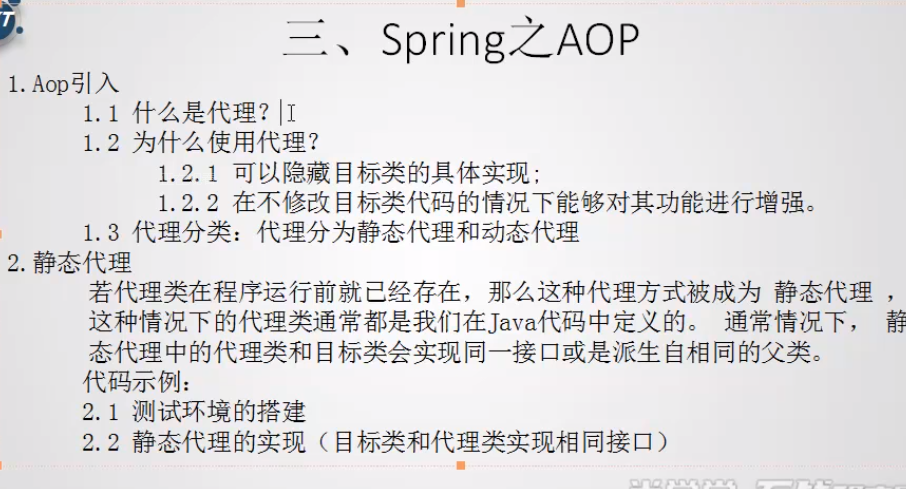
public interface SomeService {
String doSome();
}
import com.niliv.service.SomeService;
public class SomeServiceImpl implements SomeService {
public SomeServiceImpl() {
System.out.println("111");
}
@Override
public String doSome() {
return "abcd";
}
}
//ServiceProxy
import com.niliv.service.SomeService;
public class ServiceProxy implements SomeService {
SomeService target;
public ServiceProxy(SomeService target) {
super();
this.target = target;
}
public ServiceProxy() {
super();
}
public String doSome() {
return target.doSome().toUpperCase();
}
}
//test
SomeService target = new SomeServiceImpl();
SomeService proxy = new ServiceProxy(target);
String result = proxy.doSome();
System.out.println(result);
动态代理
概念
//product
package com.itheima.cglib;
/**
* 一个生产者
*/
public class Producer {
/**
* 销售
* @param money
*/
public void saleProduct(float money){
System.out.println("销售产品,并拿到钱:"+money);
}
/**
* 售后
* @param money
*/
public void afterService(float money){
System.out.println("提供售后服务,并拿到钱:"+money);
}
}
//IPRODUCTER
package com.itheima.proxy;
/**
* 对生产厂家要求的接口
*/
public interface IProducer {
/**
* 销售
* @param money
*/
public void saleProduct(float money);
/**
* 售后
* @param money
*/
public void afterService(float money);
}
package com.itheima.proxy;
import java.lang.reflect.InvocationHandler;
import java.lang.reflect.Method;
import java.lang.reflect.Proxy;
/**
* 模拟一个消费者
*/
public class Client {
public static void main(String[] args) {
final Producer producer = new Producer();
/**
* 动态代理:
* 特点:字节码随用随创建,随用随加载
* 作用:不修改源码的基础上对方法增强
* 分类:
* 基于接口的动态代理
* 基于子类的动态代理
* 基于接口的动态代理:
* 涉及的类:Proxy
* 提供者:JDK官方
* 如何创建代理对象:
* 使用Proxy类中的newProxyInstance方法
* 创建代理对象的要求:
* 被代理类最少实现一个接口,如果没有则不能使用
* newProxyInstance方法的参数:
* ClassLoader:类加载器
* 它是用于加载代理对象字节码的。和被代理对象使用相同的类加载器。固定写法。
* Class[]:字节码数组
* 它是用于让代理对象和被代理对象有相同方法。固定写法。
* InvocationHandler:用于提供增强的代码
* 它是让我们写如何代理。我们一般都是些一个该接口的实现类,通常情况下都是匿名内部类,但不是必须的。
* 此接口的实现类都是谁用谁写。
*/
IProducer proxyProducer = (IProducer) Proxy.newProxyInstance(producer.getClass().getClassLoader(),
producer.getClass().getInterfaces(),
new InvocationHandler() {
/**
* 作用:执行被代理对象的任何接口方法都会经过该方法
* 方法参数的含义
* @param proxy 代理对象的引用
* @param method 当前执行的方法
* @param args 当前执行方法所需的参数
* @return 和被代理对象方法有相同的返回值
* @throws Throwable
*/
@Override
public Object invoke(Object proxy, Method method, Object[] args) throws Throwable {
//提供增强的代码
Object returnValue = null;
//1.获取方法执行的参数
Float money = (Float)args[0];
//2.判断当前方法是不是销售
if("saleProduct".equals(method.getName())) {
returnValue = method.invoke(producer, money*0.8f);
}
return returnValue;
}
});
proxyProducer.saleProduct(10000f);
}
}
package com.itheima.cglib;
import net.sf.cglib.proxy.Enhancer;
import net.sf.cglib.proxy.MethodInterceptor;
import net.sf.cglib.proxy.MethodProxy;
import java.lang.reflect.Method;
/**
* 模拟一个消费者
*/
public class Client {
public static void main(String[] args) {
final Producer producer = new Producer();
/**
* 动态代理:
* 特点:字节码随用随创建,随用随加载
* 作用:不修改源码的基础上对方法增强
* 分类:
* 基于接口的动态代理
* 基于子类的动态代理
* 基于子类的动态代理:
* 涉及的类:Enhancer
* 提供者:第三方cglib库
* 如何创建代理对象:
* 使用Enhancer类中的create方法
* 创建代理对象的要求:
* 被代理类不能是最终类
* create方法的参数:
* Class:字节码
* 它是用于指定被代理对象的字节码。
*
* Callback:用于提供增强的代码
* 它是让我们写如何代理。我们一般都是些一个该接口的实现类,通常情况下都是匿名内部类,但不是必须的。
* 此接口的实现类都是谁用谁写。
* 我们一般写的都是该接口的子接口实现类:MethodInterceptor
*/
Producer cglibProducer = (Producer)Enhancer.create(producer.getClass(), new MethodInterceptor() {
/**
* 执行北地阿里对象的任何方法都会经过该方法
* @param proxy
* @param method
* @param args
* 以上三个参数和基于接口的动态代理中invoke方法的参数是一样的
* @param methodProxy :当前执行方法的代理对象
* @return
* @throws Throwable
*/
@Override
public Object intercept(Object proxy, Method method, Object[] args, MethodProxy methodProxy) throws Throwable {
//提供增强的代码
Object returnValue = null;
//1.获取方法执行的参数
Float money = (Float)args[0];
//2.判断当前方法是不是销售
if("saleProduct".equals(method.getName())) {
returnValue = method.invoke(producer, money*0.8f);
}
return returnValue;
}
});
cglibProducer.saleProduct(12000f);
}
}
spring 动态代理 事务
package com.itheima.dao.impl;
import com.itheima.dao.IAccountDao;
import com.itheima.domain.Account;
import com.itheima.utils.ConnectionUtils;
import org.apache.commons.dbutils.QueryRunner;
import org.apache.commons.dbutils.handlers.BeanHandler;
import org.apache.commons.dbutils.handlers.BeanListHandler;
import java.util.List;
/**
* 账户的持久层实现类
*/
public class AccountDaoImpl implements IAccountDao {
private QueryRunner runner;
private ConnectionUtils connectionUtils;
public void setRunner(QueryRunner runner) {
this.runner = runner;
}
public void setConnectionUtils(ConnectionUtils connectionUtils) {
this.connectionUtils = connectionUtils;
}
@Override
public List<Account> findAllAccount() {
try{
return runner.query(connectionUtils.getThreadConnection(),"select * from account",new BeanListHandler<Account>(Account.class));
}catch (Exception e) {
throw new RuntimeException(e);
}
}
@Override
public Account findAccountById(Integer accountId) {
try{
return runner.query(connectionUtils.getThreadConnection(),"select * from account where id = ? ",new BeanHandler<Account>(Account.class),accountId);
}catch (Exception e) {
throw new RuntimeException(e);
}
}
@Override
public void saveAccount(Account account) {
try{
runner.update(connectionUtils.getThreadConnection(),"insert into account(name,money)values(?,?)",account.getName(),account.getMoney());
}catch (Exception e) {
throw new RuntimeException(e);
}
}
@Override
public void updateAccount(Account account) {
try{
runner.update(connectionUtils.getThreadConnection(),"update account set name=?,money=? where id=?",account.getName(),account.getMoney(),account.getId());
}catch (Exception e) {
throw new RuntimeException(e);
}
}
@Override
public void deleteAccount(Integer accountId) {
try{
runner.update(connectionUtils.getThreadConnection(),"delete from account where id=?",accountId);
}catch (Exception e) {
throw new RuntimeException(e);
}
}
@Override
public Account findAccountByName(String accountName) {
try{
List<Account> accounts = runner.query(connectionUtils.getThreadConnection(),"select * from account where name = ? ",new BeanListHandler<Account>(Account.class),accountName);
if(accounts == null || accounts.size() == 0){
return null;
}
if(accounts.size() > 1){
throw new RuntimeException("结果集不唯一,数据有问题");
}
return accounts.get(0);
}catch (Exception e) {
throw new RuntimeException(e);
}
}
}
package com.itheima.service.impl;
import com.itheima.dao.IAccountDao;
import com.itheima.domain.Account;
import com.itheima.service.IAccountService;
import java.util.List;
/**
* 账户的业务层实现类
*
* 事务控制应该都是在业务层
*/
public class AccountServiceImpl implements IAccountService{
private IAccountDao accountDao;
public void setAccountDao(IAccountDao accountDao) {
this.accountDao = accountDao;
}
@Override
public List<Account> findAllAccount() {
return accountDao.findAllAccount();
}
@Override
public Account findAccountById(Integer accountId) {
return accountDao.findAccountById(accountId);
}
@Override
public void saveAccount(Account account) {
accountDao.saveAccount(account);
}
@Override
public void updateAccount(Account account) {
accountDao.updateAccount(account);
}
@Override
public void deleteAccount(Integer acccountId) {
accountDao.deleteAccount(acccountId);
}
@Override
public void transfer(String sourceName, String targetName, Float money) {
System.out.println("transfer....");
//2.1根据名称查询转出账户
Account source = accountDao.findAccountByName(sourceName);
//2.2根据名称查询转入账户
Account target = accountDao.findAccountByName(targetName);
//2.3转出账户减钱
source.setMoney(source.getMoney()-money);
//2.4转入账户加钱
target.setMoney(target.getMoney()+money);
//2.5更新转出账户
accountDao.updateAccount(source);
// int i=1/0;
//2.6更新转入账户
accountDao.updateAccount(target);
}
}
package com.itheima.factory;
import com.itheima.service.IAccountService;
import com.itheima.utils.TransactionManager;
import java.lang.reflect.InvocationHandler;
import java.lang.reflect.Method;
import java.lang.reflect.Proxy;
/**
* 用于创建Service的代理对象的工厂
*/
public class BeanFactory {
private IAccountService accountService;
private TransactionManager txManager;
public void setTxManager(TransactionManager txManager) {
this.txManager = txManager;
}
public final void setAccountService(IAccountService accountService) {
this.accountService = accountService;
}
/**
* 获取Service代理对象
* @return
*/
public IAccountService getAccountService() {
return (IAccountService)Proxy.newProxyInstance(accountService.getClass().getClassLoader(),
accountService.getClass().getInterfaces(),
new InvocationHandler() {
/**
* 添加事务的支持
*
* @param proxy
* @param method
* @param args
* @return
* @throws Throwable
*/
@Override
public Object invoke(Object proxy, Method method, Object[] args) throws Throwable {
if("test".equals(method.getName())){
return method.invoke(accountService,args);
}
Object rtValue = null;
try {
//1.开启事务
txManager.beginTransaction();
//2.执行操作
rtValue = method.invoke(accountService, args);
//3.提交事务
txManager.commit();
//4.返回结果
return rtValue;
} catch (Exception e) {
//5.回滚操作
txManager.rollback();
throw new RuntimeException(e);
} finally {
//6.释放连接
txManager.release();
}
}
});
}
}
package com.itheima.utils;
import javax.sql.DataSource;
import java.sql.Connection;
/**
* 连接的工具类,它用于从数据源中获取一个连接,并且实现和线程的绑定
*/
public class ConnectionUtils {
private ThreadLocal<Connection> tl = new ThreadLocal<Connection>();
private DataSource dataSource;
public void setDataSource(DataSource dataSource) {
this.dataSource = dataSource;
}
/**
* 获取当前线程上的连接
* @return
*/
public Connection getThreadConnection() {
try{
//1.先从ThreadLocal上获取
Connection conn = tl.get();
//2.判断当前线程上是否有连接
if (conn == null) {
//3.从数据源中获取一个连接,并且存入ThreadLocal中
conn = dataSource.getConnection();
tl.set(conn);
}
//4.返回当前线程上的连接
return conn;
}catch (Exception e){
throw new RuntimeException(e);
}
}
/**
* 把连接和线程解绑
*/
public void removeConnection(){
tl.remove();
}
}
package com.itheima.utils;
/**
* 和事务管理相关的工具类,它包含了,开启事务,提交事务,回滚事务和释放连接
*/
public class TransactionManager {
private ConnectionUtils connectionUtils;
public void setConnectionUtils(ConnectionUtils connectionUtils) {
this.connectionUtils = connectionUtils;
}
/**
* 开启事务
*/
public void beginTransaction(){
try {
connectionUtils.getThreadConnection().setAutoCommit(false);
}catch (Exception e){
e.printStackTrace();
}
}
/**
* 提交事务
*/
public void commit(){
try {
connectionUtils.getThreadConnection().commit();
}catch (Exception e){
e.printStackTrace();
}
}
/**
* 回滚事务
*/
public void rollback(){
try {
connectionUtils.getThreadConnection().rollback();
}catch (Exception e){
e.printStackTrace();
}
}
/**
* 释放连接
*/
public void release(){
try {
connectionUtils.getThreadConnection().close();//还回连接池中
connectionUtils.removeConnection();
}catch (Exception e){
e.printStackTrace();
}
}
}
<?xml version="1.0" encoding="UTF-8"?>
<beans xmlns="http://www.springframework.org/schema/beans"
xmlns:xsi="http://www.w3.org/2001/XMLSchema-instance"
xsi:schemaLocation="http://www.springframework.org/schema/beans
http://www.springframework.org/schema/beans/spring-beans.xsd">
<!--配置代理的service-->
<bean id="proxyAccountService" factory-bean="beanFactory" factory-method="getAccountService"></bean>
<!--配置beanfactory-->
<bean id="beanFactory" class="com.itheima.factory.BeanFactory">
<!-- 注入service -->
<property name="accountService" ref="accountService"></property>
<!-- 注入事务管理器 -->
<property name="txManager" ref="txManager"></property>
</bean>
<!-- 配置Service -->
<bean id="accountService" class="com.itheima.service.impl.AccountServiceImpl">
<!-- 注入dao -->
<property name="accountDao" ref="accountDao"></property>
</bean>
<!--配置Dao对象-->
<bean id="accountDao" class="com.itheima.dao.impl.AccountDaoImpl">
<!-- 注入QueryRunner -->
<property name="runner" ref="runner"></property>
<!-- 注入ConnectionUtils -->
<property name="connectionUtils" ref="connectionUtils"></property>
</bean>
<!--配置QueryRunner-->
<bean id="runner" class="org.apache.commons.dbutils.QueryRunner" scope="prototype"></bean>
<!-- 配置数据源 -->
<bean id="dataSource" class="com.mchange.v2.c3p0.ComboPooledDataSource">
<!--连接数据库的必备信息-->
<property name="driverClass" value="com.mysql.jdbc.Driver"></property>
<property name="jdbcUrl" value="jdbc:mysql://118.24.175.34:3306/java_test"></property>
<property name="user" value="root"></property>
<property name="password" value="p@ssw0rd"></property>
</bean>
<!-- 配置Connection的工具类 ConnectionUtils -->
<bean id="connectionUtils" class="com.itheima.utils.ConnectionUtils">
<!-- 注入数据源-->
<property name="dataSource" ref="dataSource"></property>
</bean>
<!-- 配置事务管理器-->
<bean id="txManager" class="com.itheima.utils.TransactionManager">
<!-- 注入ConnectionUtils -->
<property name="connectionUtils" ref="connectionUtils"></property>
</bean>
</beans>

jdk
final SomeService target = new SomeServiceImpl();
SomeService proxy = (SomeService)Proxy.newProxyInstance(target.getClass().getClassLoader(), //目标类加载器
target.getClass().getInterfaces(), //目标类实现的所有接口
new InvocationHandler() { //调用处理器
//proxy 代理对象
//method 目标方法
//args 目标方法参数
@Override
public Object invoke(Object proxy, Method method, Object[] args) throws Throwable {
String result =(String)method.invoke(target, args);
return result.toUpperCase(); }});
String result1 = proxy.doSome();
System.out.println(result1);
cglib
public class SomeServiceImpl {
public SomeServiceImpl() {
System.out.println("111");
}
public String doSome() {
return "abcd";
}
}
import com.niliv.service.impl.SomeServiceImpl;
import net.sf.cglib.proxy.Enhancer;
import net.sf.cglib.proxy.MethodInterceptor;
import net.sf.cglib.proxy.MethodProxy;
public class CglibProxyFactory implements MethodInterceptor {
private SomeServiceImpl target;
public CglibProxyFactory() {
super();
}
public CglibProxyFactory(SomeServiceImpl target) {
super();
this.target = target;
}
public SomeServiceImpl proxyCreator() {
//创建增强器
Enhancer enhancer = new Enhancer();
//指定父类
enhancer.setSuperclass(SomeServiceImpl.class);
//指定回调接口对象
enhancer.setCallback(this);
//创建cglib代理对象
return (SomeServiceImpl)enhancer.create();
}
@Override
public Object intercept(Object obj, Method method, Object[] args, MethodProxy proxy) throws Throwable {
String result = (String)method.invoke(target, args);
return result.toUpperCase();
}
}
SomeServiceImpl target = new SomeServiceImpl();
SomeServiceImpl proxy = new CglibProxyFactory(target).proxyCreator();
String result1 = proxy.doSome();
System.out.println(result1);
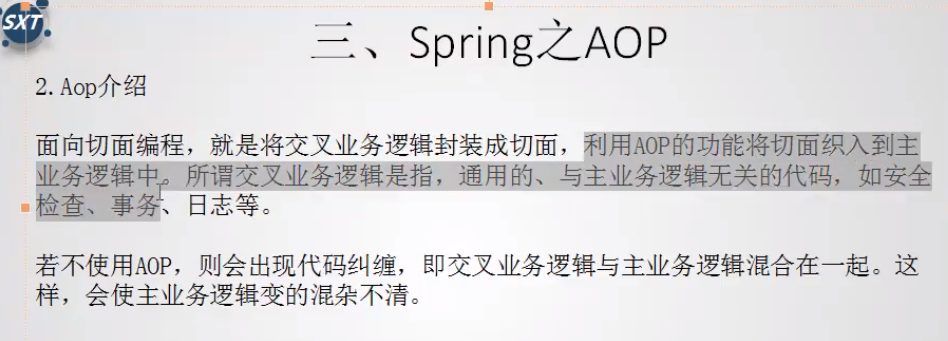
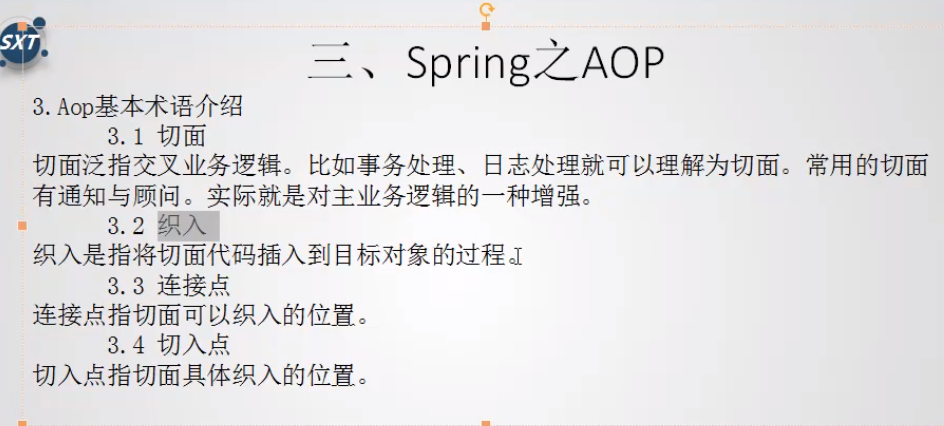
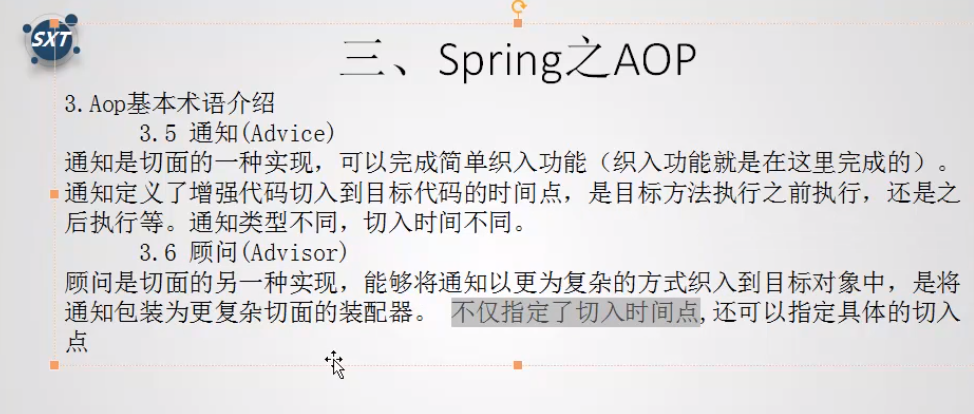
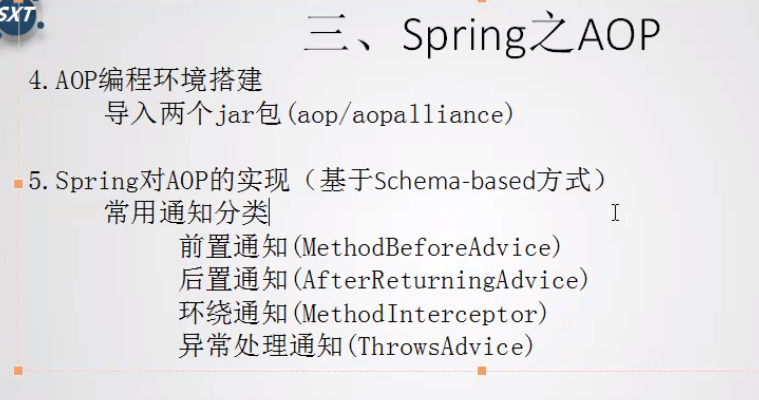
Joinpoint( 连接点):
所谓连接点是指那些被拦截到的点。在 spring 中,这些点指的是方法,因为 spring 只支持方法类型的
连接点。
Pointcut( 切入点):
所谓切入点是指我们要对哪些 Joinpoint 进行拦截的定义。
Advice( 通知/ 增强):
所谓通知是指拦截到 Joinpoint 之后所要做的事情就是通知。
通知的类型:前置通知,后置通知,异常通知,最终通知,环绕通知。
Introduction( 引介):
引介是一种特殊的通知在不修改类代码的前提下, Introduction 可以在运行期为类动态地添加一些方
法或 Field。
Target( 目标对象):
代理的目标对象。
Weaving( 织入):
是指把增强应用到目标对象来创建新的代理对象的过程。
spring 采用动态代理织入,而 AspectJ 采用编译期织入和类装载期织入。
Proxy (代理):
一个类被 AOP 织入增强后,就产生一个结果代理类。
Aspect( 切面):
是切入点和通知(引介)的结合。
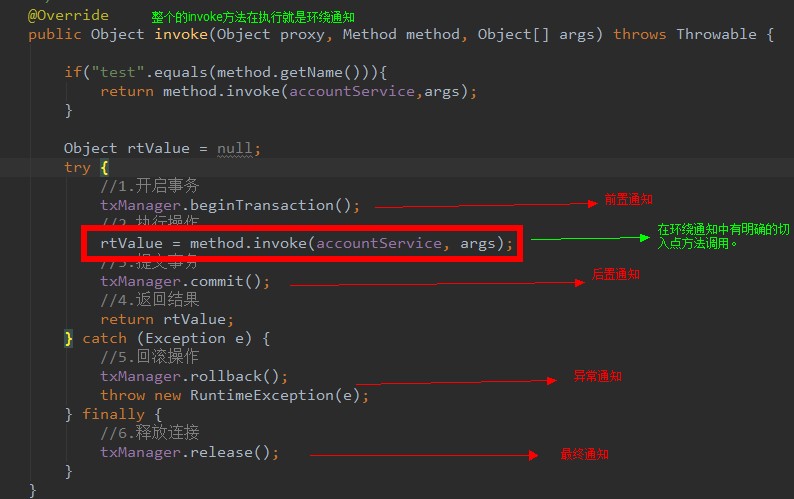
a 、开发阶段(我们做的)
编写核心业务代码(开发主线):大部分程序员来做,要求熟悉业务需求。
把公用代码抽取出来,制作成通知。(开发阶段最后再做):AOP 编程人员来做。
在配置文件中,声明切入点与通知间的关系,即切面。:AOP 编程人员来做。
b 、运行阶段(Spring 框架完成的)
Spring 框架监控切入点方法的执行。一旦监控到切入点方法被运行,使用代理机制,动态创建目标对
象的代理对象,根据通知类别,在代理对象的对应位置,将通知对应的功能织入,完成完整的代码逻辑运行。
schema-based 通知 前置 后置 环绕 异常
public interface SomeService {
void doSome();
String doOther();
}
import com.niliv.service.SomeService;
public class SomeServiceImpl implements SomeService {
public SomeServiceImpl() {
System.out.println("111");
}
@Override
public void doSome() {
System.out.println("doSome执行"+1/0);
}
@Override
public String doOther() {
System.err.println("doOther执行");
return "love";
}
}
<!-- 注册目标类 -->
<bean id="someServiceImpl" class="com.niliv.service.impl.SomeServiceImpl"></bean>
<!-- 注册切面 前置通知 -->
<bean id="myMethodBeforeAdvice" class="com.niliv.aspects.MyMethodBeforeAdvice"></bean>
<!-- 注册切面 后置通知 -->
<bean id="myAfterReturningAdvice" class="com.niliv.aspects.MyAfterReturningAdvice"></bean>
<!-- 注册切面 环绕通知 -->
<bean id="myMethodInterceptor" class="com.niliv.aspects.MyMethodInterceptor"></bean>
<!-- 注册切面 异常通知 -->
<bean id="myThrowAdvice" class="com.niliv.aspects.MyThrowAdvice"></bean>
<!-- 注册代理 -->
<bean id="proxyFactoryBean" class="org.springframework.aop.framework.ProxyFactoryBean">
<!-- 指定目标对象 -->
<property name="target" ref="someServiceImpl"></property>
<!-- 指定目标类实现的接口 -->
<property name="interfaces" value="com.niliv.service.SomeService"></property>
<!-- 指定前置切面
<property name="interceptorNames" value="myMethodBeforeAdvice"></property>
-->
<!-- 指定后置切面
<property name="interceptorNames" value="myAfterReturningAdvice"></property>
-->
<!-- 指定环绕切面
<property name="interceptorNames" value="myMethodInterceptor"></property>
-->
<!-- 指定异常切面 -->
<property name="interceptorNames" value="myThrowAdvice"></property>
</bean>
import java.lang.reflect.Method;
import org.springframework.aop.AfterReturningAdvice;
//切面 后置通知
public class MyAfterReturningAdvice implements AfterReturningAdvice {
/**
* returnvalue 目标方法的返回值
*/
@Override
public void afterReturning(Object returnValue, Method method, Object[] args, Object target) throws Throwable {
System.out.println("后置通知after执行 "+returnValue);
if(returnValue!=null) {
System.err.println(((String)returnValue).toUpperCase());
}
}
}
import java.lang.reflect.Method;
import org.springframework.aop.MethodBeforeAdvice;
//切面 前置通知
public class MyMethodBeforeAdvice implements MethodBeforeAdvice{
//method 目标方法
//args 目标方法的参数
//target 目标对象
@Override
public void before(Method method, Object[] args, Object target) throws Throwable {
System.out.println("前置before执行");
}
}
import org.aopalliance.intercept.MethodInterceptor;
import org.aopalliance.intercept.MethodInvocation;
public class MyMethodInterceptor implements MethodInterceptor {
/**
* invocation 方法调用器
*/
@Override
public Object invoke(MethodInvocation invocation) throws Throwable {
System.out.println("环绕通知 目标方法之前");
//调用目标方法
Object result = invocation.proceed();
if(result!=null) {
result = ((String)result).toUpperCase();
}
System.out.println("环绕通知 目标方法之后");
return result;
}
}
import org.springframework.aop.ThrowsAdvice;
//切面 异常通知
public class MyThrowAdvice implements ThrowsAdvice{
public void afterThrowing(Exception ex) {
System.out.println("异常通知执行");
}
}
@Test
public void someTest01() {
ApplicationContext ac = new ClassPathXmlApplicationContext("applicationContext.xml");
SomeService service = ac.getBean("proxyFactoryBean",SomeService.class);
service.doSome();
System.out.println(service.doOther());
/**
* 前置通知
* 111
前置before执行
doSome执行
前置before执行
doOther执行
love
*/
/**
* 后置通知
* 111
doSome执行
后置通知after执行 null
doOther执行
后置通知after执行 love
LOVE
love
*/
/**
* 环绕通知
* 111
环绕通知 目标方法之前
doSome执行
环绕通知 目标方法之后
环绕通知 目标方法之前
doOther执行
环绕通知 目标方法之后
LOVE
*/
/**
* 异常通知
* 111
异常通知执行
*/
}
AspectJ通知
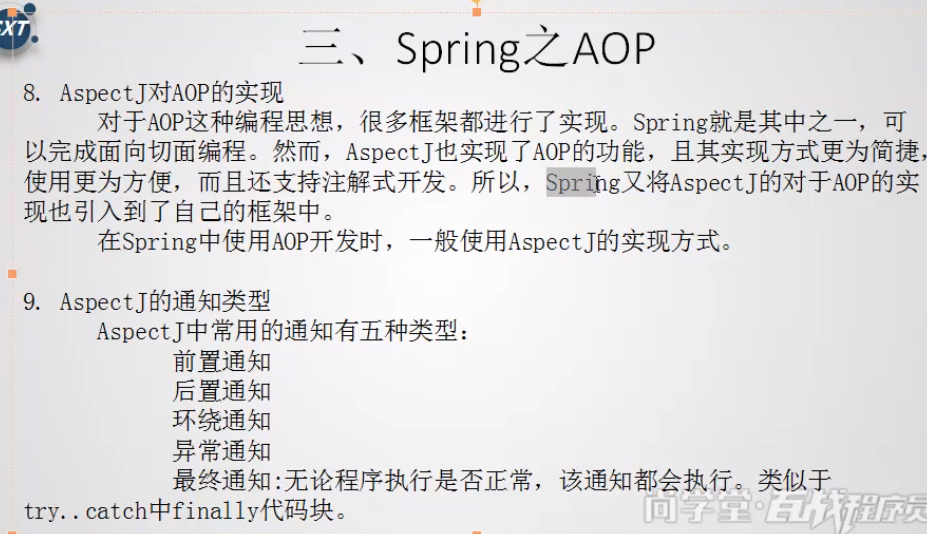
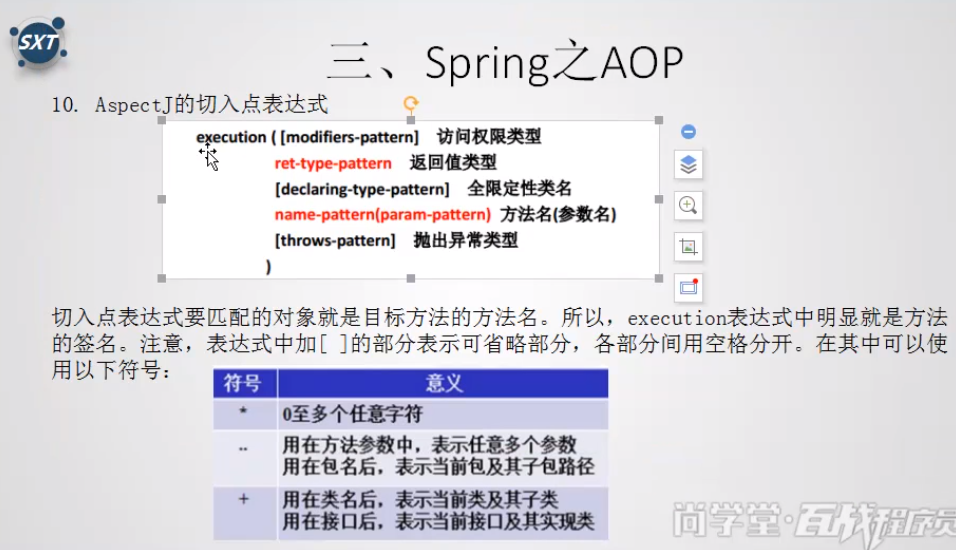
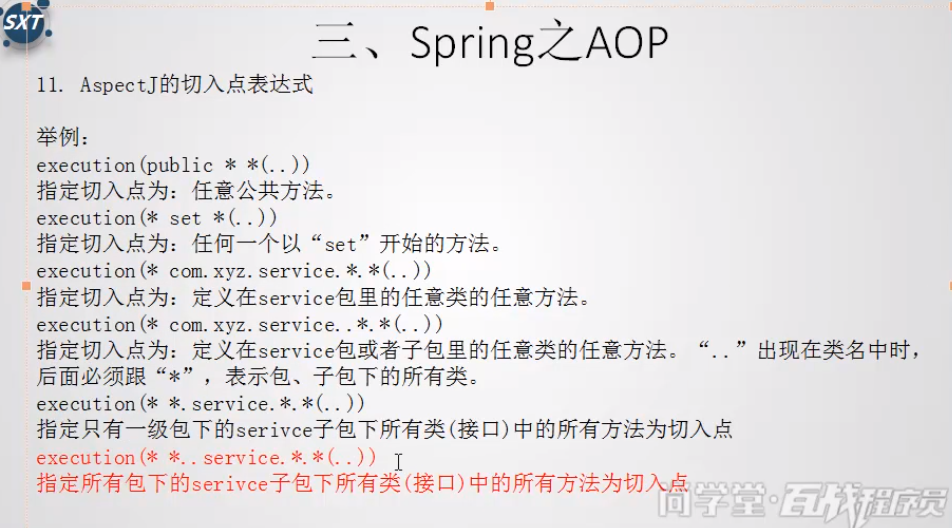

注解方式
最终通知会跑到异常和后置前面,这是注解的问题,如果要用注解,尽量用环绕通知
<?xml version="1.0" encoding="UTF-8"?>
<beans xmlns="http://www.springframework.org/schema/beans"
xmlns:xsi="http://www.w3.org/2001/XMLSchema-instance"
xmlns:aop="http://www.springframework.org/schema/aop"
xmlns:context="http://www.springframework.org/schema/context"
xsi:schemaLocation="http://www.springframework.org/schema/beans
http://www.springframework.org/schema/beans/spring-beans.xsd
http://www.springframework.org/schema/aop
http://www.springframework.org/schema/aop/spring-aop.xsd
http://www.springframework.org/schema/context
http://www.springframework.org/schema/context/spring-context.xsd">
<!-- 配置spring创建容器时要扫描的包-->
<context:component-scan base-package="com.itheima"></context:component-scan>
<!-- 配置spring开启注解AOP的支持 -->
<aop:aspectj-autoproxy></aop:aspectj-autoproxy>
</beans>
package com.itheima.utils;
import org.aspectj.lang.ProceedingJoinPoint;
import org.aspectj.lang.annotation.*;
import org.springframework.stereotype.Component;
/**
* 用于记录日志的工具类,它里面提供了公共的代码
*/
@Component("logger")
@Aspect//表示当前类是一个切面类
public class Logger {
@Pointcut("execution(* com.itheima.service.impl.*.*(..))")
private void pt1(){}
/**
* 前置通知
*/
// @Before("pt1()")
public void beforePrintLog(){
System.out.println("前置通知Logger类中的beforePrintLog方法开始记录日志了。。。");
}
/**
* 后置通知
*/
// @AfterReturning("pt1()")
public void afterReturningPrintLog(){
System.out.println("后置通知Logger类中的afterReturningPrintLog方法开始记录日志了。。。");
}
/**
* 异常通知
*/
// @AfterThrowing("pt1()")
public void afterThrowingPrintLog(){
System.out.println("异常通知Logger类中的afterThrowingPrintLog方法开始记录日志了。。。");
}
/**
* 最终通知
*/
// @After("pt1()")
public void afterPrintLog(){
System.out.println("最终通知Logger类中的afterPrintLog方法开始记录日志了。。。");
}
/**
* 环绕通知
* 问题:
* 当我们配置了环绕通知之后,切入点方法没有执行,而通知方法执行了。
* 分析:
* 通过对比动态代理中的环绕通知代码,发现动态代理的环绕通知有明确的切入点方法调用,而我们的代码中没有。
* 解决:
* Spring框架为我们提供了一个接口:ProceedingJoinPoint。该接口有一个方法proceed(),此方法就相当于明确调用切入点方法。
* 该接口可以作为环绕通知的方法参数,在程序执行时,spring框架会为我们提供该接口的实现类供我们使用。
*
* spring中的环绕通知:
* 它是spring框架为我们提供的一种可以在代码中手动控制增强方法何时执行的方式。
*/
@Around("pt1()")
public Object aroundPringLog(ProceedingJoinPoint pjp){
Object rtValue = null;
try{
Object[] args = pjp.getArgs();//得到方法执行所需的参数
System.out.println("Logger类中的aroundPringLog方法开始记录日志了。。。前置");
rtValue = pjp.proceed(args);//明确调用业务层方法(切入点方法)
System.out.println("Logger类中的aroundPringLog方法开始记录日志了。。。后置");
return rtValue;
}catch (Throwable t){
System.out.println("Logger类中的aroundPringLog方法开始记录日志了。。。异常");
throw new RuntimeException(t);
}finally {
System.out.println("Logger类中的aroundPringLog方法开始记录日志了。。。最终");
}
}
}
注解事务
必须使用环绕通知,因为注解方式,最终通知会跑到前面去,提前关闭连接
<?xml version="1.0" encoding="UTF-8"?>
<beans xmlns="http://www.springframework.org/schema/beans"
xmlns:xsi="http://www.w3.org/2001/XMLSchema-instance"
xmlns:aop="http://www.springframework.org/schema/aop"
xmlns:context="http://www.springframework.org/schema/context"
xsi:schemaLocation="http://www.springframework.org/schema/beans
http://www.springframework.org/schema/beans/spring-beans.xsd
http://www.springframework.org/schema/aop
http://www.springframework.org/schema/aop/spring-aop.xsd
http://www.springframework.org/schema/context
http://www.springframework.org/schema/context/spring-context.xsd">
<!--配置spring创建容器时要扫描的包-->
<context:component-scan base-package="com.itheima"></context:component-scan>
<!--配置QueryRunner-->
<bean id="runner" class="org.apache.commons.dbutils.QueryRunner" scope="prototype"></bean>
<!-- 配置数据源 -->
<bean id="dataSource" class="com.mchange.v2.c3p0.ComboPooledDataSource">
<!--连接数据库的必备信息-->
<property name="driverClass" value="com.mysql.jdbc.Driver"></property>
<property name="jdbcUrl" value="jdbc:mysql://localhost:3306/eesy"></property>
<property name="user" value="root"></property>
<property name="password" value="1234"></property>
</bean>
<!--开启spring对注解AOP的支持-->
<aop:aspectj-autoproxy></aop:aspectj-autoproxy>
</beans>
package com.itheima.utils;
import org.aspectj.lang.ProceedingJoinPoint;
import org.aspectj.lang.annotation.*;
import org.springframework.beans.factory.annotation.Autowired;
import org.springframework.stereotype.Component;
/**
* 和事务管理相关的工具类,它包含了,开启事务,提交事务,回滚事务和释放连接
*/
@Component("txManager")
@Aspect
public class TransactionManager {
@Autowired
private ConnectionUtils connectionUtils;
@Pointcut("execution(* com.itheima.service.impl.*.*(..))")
private void pt1(){}
/**
* 开启事务
*/
public void beginTransaction(){
try {
connectionUtils.getThreadConnection().setAutoCommit(false);
}catch (Exception e){
e.printStackTrace();
}
}
/**
* 提交事务
*/
public void commit(){
try {
connectionUtils.getThreadConnection().commit();
}catch (Exception e){
e.printStackTrace();
}
}
/**
* 回滚事务
*/
public void rollback(){
try {
connectionUtils.getThreadConnection().rollback();
}catch (Exception e){
e.printStackTrace();
}
}
/**
* 释放连接
*/
public void release(){
try {
connectionUtils.getThreadConnection().close();//还回连接池中
connectionUtils.removeConnection();
}catch (Exception e){
e.printStackTrace();
}
}
@Around("pt1()")
public Object aroundAdvice(ProceedingJoinPoint pjp){
Object rtValue = null;
try {
//1.获取参数
Object[] args = pjp.getArgs();
//2.开启事务
this.beginTransaction();
//3.执行方法
rtValue = pjp.proceed(args);
//4.提交事务
this.commit();
//返回结果
return rtValue;
}catch (Throwable e){
//5.回滚事务
this.rollback();
throw new RuntimeException(e);
}finally {
//6.释放资源
this.release();
}
}
}
//切面类
@Aspect //当前类是一个切面
public class MyAspect {
// //前置通知
// @Before("execution(* *..service.*.doSome(..))")
// public void before() {
// System.out.println("前置通知执行");
// }
// //后置通知
// @AfterReturning(value="execution(* *..service.*.doOther(..))",returning="result")
// public void afterReturning(Object result) {
// System.out.println("后置通知执行 返回值是 "+result);
// }
// //环绕通知
// @Around("execution(* *..service.*.doOther(..))")
// public Object around(ProceedingJoinPoint pjp) throws Throwable {
// System.out.println("环绕通知 目标方法前");
// String result = (String)pjp.proceed();
// if(result!=null) {
// result = result.toUpperCase();
// }
// System.out.println("环绕通知 目标方法后");
// return result;
// }
//异常通知
// @AfterThrowing(value="execution(* *..service.*.doSome(..))",throwing ="ex" )
// public void throwing(Exception ex) {
// System.err.println(ex);
// }
//最终通知
@After("execution(* *..service.*.doSome(..))")
public void after() {
System.out.println("最终通知");
}
}
<?xml version="1.0" encoding="UTF-8"?>
<beans xmlns="http://www.springframework.org/schema/beans"
xmlns:xsi="http://www.w3.org/2001/XMLSchema-instance"
xmlns:aop="http://www.springframework.org/schema/aop"
xsi:schemaLocation="http://www.springframework.org/schema/beans
http://www.springframework.org/schema/beans/spring-beans.xsd
http://www.springframework.org/schema/aop
http://www.springframework.org/schema/aop/spring-aop.xsd"> <!-- bean definitions here -->
<!-- 注册目标类 -->
<bean id="someServiceImpl" class="com.niliv.service.impl.SomeServiceImpl"></bean>
<!-- 注册切面 -->
<bean id="myAspect" class="com.niliv.aspects.MyAspect"></bean>
<!-- 注册切面 -->
<aop:aspectj-autoproxy/>
</beans>
@Test
public void someTest01() {
ApplicationContext ac = new ClassPathXmlApplicationContext("applicationContext.xml");
SomeService service = ac.getBean("someServiceImpl",SomeService.class);
service.doSome();
System.out.println(service.doOther());
/**
* aspectj
* 注解:前置通知
* 111
前置通知执行
doSome执行
doOther执行
love
*/
/**
* aspectj
* 注解:后置通知
* 111
doSome执行
doOther执行
后置通知执行 返回值是 love
love
*/
/**
* aspectj
* 注解:环绕通知
* 111
doSome执行
环绕通知 目标方法前
doOther执行
环绕通知 目标方法后
LOVE
*/
/**
* aspectj
* 注解:异常通知
* 111
java.lang.ArithmeticException: / by zero
*/
/**
* aspectj
* 注解:最终通知
* 111
最终通知
*/
}
配置方式
日志注入bean
<?xml version="1.0" encoding="UTF-8"?>
<beans xmlns="http://www.springframework.org/schema/beans"
xmlns:xsi="http://www.w3.org/2001/XMLSchema-instance"
xmlns:aop="http://www.springframework.org/schema/aop"
xsi:schemaLocation="http://www.springframework.org/schema/beans
http://www.springframework.org/schema/beans/spring-beans.xsd
http://www.springframework.org/schema/aop
http://www.springframework.org/schema/aop/spring-aop.xsd">
<!-- 配置srping的Ioc,把service对象配置进来-->
<bean id="accountService" class="com.itheima.service.impl.AccountServiceImpl"></bean>
<!--spring中基于XML的AOP配置步骤
1、把通知Bean也交给spring来管理
2、使用aop:config标签表明开始AOP的配置
3、使用aop:aspect标签表明配置切面
id属性:是给切面提供一个唯一标识
ref属性:是指定通知类bean的Id。
4、在aop:aspect标签的内部使用对应标签来配置通知的类型
我们现在示例是让printLog方法在切入点方法执行之前之前:所以是前置通知
aop:before:表示配置前置通知
method属性:用于指定Logger类中哪个方法是前置通知
pointcut属性:用于指定切入点表达式,该表达式的含义指的是对业务层中哪些方法增强
切入点表达式的写法:
关键字:execution(表达式)
表达式:
访问修饰符 返回值 包名.包名.包名...类名.方法名(参数列表)
标准的表达式写法:
public void com.itheima.service.impl.AccountServiceImpl.saveAccount()
访问修饰符可以省略
void com.itheima.service.impl.AccountServiceImpl.saveAccount()
返回值可以使用通配符,表示任意返回值
* com.itheima.service.impl.AccountServiceImpl.saveAccount()
包名可以使用通配符,表示任意包。但是有几级包,就需要写几个*.
* *.*.*.*.AccountServiceImpl.saveAccount())
包名可以使用..表示当前包及其子包
* *..AccountServiceImpl.saveAccount()
类名和方法名都可以使用*来实现通配
* *..*.*()
参数列表:
可以直接写数据类型:
基本类型直接写名称 int
引用类型写包名.类名的方式 java.lang.String
可以使用通配符表示任意类型,但是必须有参数
可以使用..表示有无参数均可,有参数可以是任意类型
全通配写法:
* *..*.*(..)
-->
<!-- 配置Logger类 -->
<bean id="logger" class="com.itheima.utils.Logger"></bean>
<!--配置AOP-->
<aop:config>
<!--配置切面 -->
<aop:aspect id="logAdvice" ref="logger">
<!-- 配置通知的类型,并且建立通知方法和切入点方法的关联-->
<aop:before method="printLog" pointcut="execution(* *..*.*(..))"></aop:before>
</aop:aspect>
</aop:config>
</beans>
xml 日志
<?xml version="1.0" encoding="UTF-8"?>
<beans xmlns="http://www.springframework.org/schema/beans"
xmlns:xsi="http://www.w3.org/2001/XMLSchema-instance"
xmlns:aop="http://www.springframework.org/schema/aop"
xsi:schemaLocation="http://www.springframework.org/schema/beans
http://www.springframework.org/schema/beans/spring-beans.xsd
http://www.springframework.org/schema/aop
http://www.springframework.org/schema/aop/spring-aop.xsd">
<!-- 配置srping的Ioc,把service对象配置进来-->
<bean id="accountService" class="com.itheima.service.impl.AccountServiceImpl"></bean>
<!--spring中基于XML的AOP配置步骤
1、把通知Bean也交给spring来管理
2、使用aop:config标签表明开始AOP的配置
3、使用aop:aspect标签表明配置切面
id属性:是给切面提供一个唯一标识
ref属性:是指定通知类bean的Id。
4、在aop:aspect标签的内部使用对应标签来配置通知的类型
我们现在示例是让printLog方法在切入点方法执行之前之前:所以是前置通知
aop:before:表示配置前置通知
method属性:用于指定Logger类中哪个方法是前置通知
pointcut属性:用于指定切入点表达式,该表达式的含义指的是对业务层中哪些方法增强
切入点表达式的写法:
关键字:execution(表达式)
表达式:
访问修饰符 返回值 包名.包名.包名...类名.方法名(参数列表)
标准的表达式写法:
public void com.itheima.service.impl.AccountServiceImpl.saveAccount()
访问修饰符可以省略
void com.itheima.service.impl.AccountServiceImpl.saveAccount()
返回值可以使用通配符,表示任意返回值
* com.itheima.service.impl.AccountServiceImpl.saveAccount()
包名可以使用通配符,表示任意包。但是有几级包,就需要写几个*.
* *.*.*.*.AccountServiceImpl.saveAccount())
包名可以使用..表示当前包及其子包
* *..AccountServiceImpl.saveAccount()
类名和方法名都可以使用*来实现通配
* *..*.*()
参数列表:
可以直接写数据类型:
基本类型直接写名称 int
引用类型写包名.类名的方式 java.lang.String
可以使用通配符表示任意类型,但是必须有参数
可以使用..表示有无参数均可,有参数可以是任意类型
全通配写法:
* *..*.*(..)
-->
<!-- 配置Logger类 -->
<bean id="logger" class="com.itheima.utils.Logger"></bean>
<!--配置AOP-->
<aop:config>
<!-- 配置切入点表达式 id属性用于指定表达式的唯一标识。expression属性用于指定表达式内容
此标签写在aop:aspect标签内部只能当前切面使用。
它还可以写在aop:aspect外面,此时就变成了所有切面可用
-->
<aop:pointcut id="pt1" expression="execution(* com.itheima.service.impl.*.*(..))"></aop:pointcut>
<!--配置切面 -->
<aop:aspect id="logAdvice" ref="logger">
<!-- 配置前置通知:在切入点方法执行之前执行
<aop:before method="beforePrintLog" pointcut-ref="pt1" ></aop:before>-->
<!-- 配置后置通知:在切入点方法正常执行之后值。它和异常通知永远只能执行一个
<aop:after-returning method="afterReturningPrintLog" pointcut-ref="pt1"></aop:after-returning>-->
<!-- 配置异常通知:在切入点方法执行产生异常之后执行。它和后置通知永远只能执行一个
<aop:after-throwing method="afterThrowingPrintLog" pointcut-ref="pt1"></aop:after-throwing>-->
<!-- 配置最终通知:无论切入点方法是否正常执行它都会在其后面执行
<aop:after method="afterPrintLog" pointcut-ref="pt1"></aop:after>-->
<!-- 配置环绕通知 详细的注释请看Logger类中-->
<aop:around method="aroundPringLog" pointcut-ref="pt1"></aop:around>
</aop:aspect>
</aop:config>
</beans>
package com.itheima.utils;
import org.aspectj.lang.ProceedingJoinPoint;
/**
* 用于记录日志的工具类,它里面提供了公共的代码
*/
public class Logger {
/**
* 前置通知
*/
public void beforePrintLog(){
System.out.println("前置通知Logger类中的beforePrintLog方法开始记录日志了。。。");
}
/**
* 后置通知
*/
public void afterReturningPrintLog(){
System.out.println("后置通知Logger类中的afterReturningPrintLog方法开始记录日志了。。。");
}
/**
* 异常通知
*/
public void afterThrowingPrintLog(){
System.out.println("异常通知Logger类中的afterThrowingPrintLog方法开始记录日志了。。。");
}
/**
* 最终通知
*/
public void afterPrintLog(){
System.out.println("最终通知Logger类中的afterPrintLog方法开始记录日志了。。。");
}
/**
* 环绕通知
* 问题:
* 当我们配置了环绕通知之后,切入点方法没有执行,而通知方法执行了。
* 分析:
* 通过对比动态代理中的环绕通知代码,发现动态代理的环绕通知有明确的切入点方法调用,而我们的代码中没有。
* 解决:
* Spring框架为我们提供了一个接口:ProceedingJoinPoint。该接口有一个方法proceed(),此方法就相当于明确调用切入点方法。
* 该接口可以作为环绕通知的方法参数,在程序执行时,spring框架会为我们提供该接口的实现类供我们使用。
*
* spring中的环绕通知:
* 它是spring框架为我们提供的一种可以在代码中手动控制增强方法何时执行的方式。
*/
public Object aroundPringLog(ProceedingJoinPoint pjp){
Object rtValue = null;
try{
Object[] args = pjp.getArgs();//得到方法执行所需的参数
System.out.println("Logger类中的aroundPringLog方法开始记录日志了。。。前置");
rtValue = pjp.proceed(args);//明确调用业务层方法(切入点方法)
System.out.println("Logger类中的aroundPringLog方法开始记录日志了。。。后置");
return rtValue;
}catch (Throwable t){
System.out.println("Logger类中的aroundPringLog方法开始记录日志了。。。异常");
throw new RuntimeException(t);
}finally {
System.out.println("Logger类中的aroundPringLog方法开始记录日志了。。。最终");
}
}
}
package com.itheima.service.impl;
import com.itheima.service.IAccountService;
/**
* 账户的业务层实现类
*/
public class AccountServiceImpl implements IAccountService{
@Override
public void saveAccount() {
System.out.println("执行了保存");
// int i=1/0;
}
@Override
public void updateAccount(int i) {
System.out.println("执行了更新"+i);
}
@Override
public int deleteAccount() {
System.out.println("执行了删除");
return 0;
}
}
/**
* 测试AOP的配置
*/
public class AOPTest {
public static void main(String[] args) {
//1.获取容器
ApplicationContext ac = new ClassPathXmlApplicationContext("bean.xml");
//2.获取对象
IAccountService as = (IAccountService)ac.getBean("accountService");
//3.执行方法
as.saveAccount();
as.updateAccount(1);
as.deleteAccount();
}
}
dosome doother
//切面类
public class MyAspect {
//前置通知
// public void before() {
// System.out.println("前置通知执行");
// }
//
// public void before(JoinPoint jp) {
// System.out.println("前置通知执行 "+jp);
// }
//后置通知
// public void afterReturning(Object result) {
// System.out.println("后置通知执行 返回值是 "+result);
// }
//环绕通知
// public Object around(ProceedingJoinPoint pjp) throws Throwable {
// System.out.println("环绕通知 目标方法前");
// String result = (String)pjp.proceed();
// if(result!=null) {
// result = result.toUpperCase();
// }
// System.out.println("环绕通知 目标方法后");
// return result;
// }
//异常通知
// public void throwing(Exception ex) {
// System.err.println(ex);
// }
//最终通知
public void after() {
System.out.println("最终通知");
}
}
<?xml version="1.0" encoding="UTF-8"?>
<beans xmlns="http://www.springframework.org/schema/beans"
xmlns:xsi="http://www.w3.org/2001/XMLSchema-instance"
xmlns:aop="http://www.springframework.org/schema/aop"
xsi:schemaLocation="http://www.springframework.org/schema/beans
http://www.springframework.org/schema/beans/spring-beans.xsd
http://www.springframework.org/schema/aop
http://www.springframework.org/schema/aop/spring-aop.xsd"> <!-- bean definitions here -->
<!-- 注册目标类 -->
<bean id="someServiceImpl" class="com.niliv.service.impl.SomeServiceImpl"></bean>
<!-- 注册切面 -->
<bean id="myAspect" class="com.niliv.aspects.MyAspect"></bean>
<!-- 注册切面 -->
<aop:config>
<aop:pointcut expression="execution(* *..service.*.doSome(..))" id="doSomePC"/>
<aop:pointcut expression="execution(* *..service.*.doOther(..))" id="doOtherPC"/>
<aop:aspect ref="myAspect">
<!--<aop:before method="before" pointcut-ref="doSomePC"/>-->
<!-- 带参的前置通知 -->
<!--<aop:before method="before(org.aspectj.lang.JoinPoint)" pointcut-ref="doSomePC"/>-->
<!--<aop:after-returning method="afterReturning(java.lang.Object)" pointcut-ref="doOtherPC" returning="result"/>-->
<!--<aop:around method="around" pointcut-ref="doOtherPC"/>-->
<!--<aop:after-throwing method="throwing(java.lang.Exception)" pointcut-ref="doSomePC" throwing="ex"/>-->
<aop:after method="after" pointcut-ref="doSomePC"/>
</aop:aspect>
</aop:config>
</beans>
@Test
public void someTest01() {
ApplicationContext ac = new ClassPathXmlApplicationContext("applicationContext.xml");
SomeService service = ac.getBean("someServiceImpl",SomeService.class);
service.doSome();
System.out.println(service.doOther());
/**
* aspectj
* 配置:前置通知
* 111
前置通知执行
doSome执行
doOther执行
love
*/
/**aspectj
* 配置:带参数前置通知
* 111
前置通知执行 execution(void com.niliv.service.SomeService.doSome())
doSome执行
doOther执行
love
*/
/**
* aspectj
* 配置:后置通知
* 111
doSome执行
doOther执行
后置通知执行 返回值是 love
love
*/
/**
* aspectj
* 配置:环绕通知
* 111
doSome执行
环绕通知 目标方法前
doOther执行
环绕通知 目标方法后
LOVE
*/
/**
* aspectj
* 配置:异常通知
* 111
java.lang.ArithmeticException: / by zero
*/
/**
* aspectj
* 配置:最终通知
* 111
最终通知
*/
}
JDBCTemplate
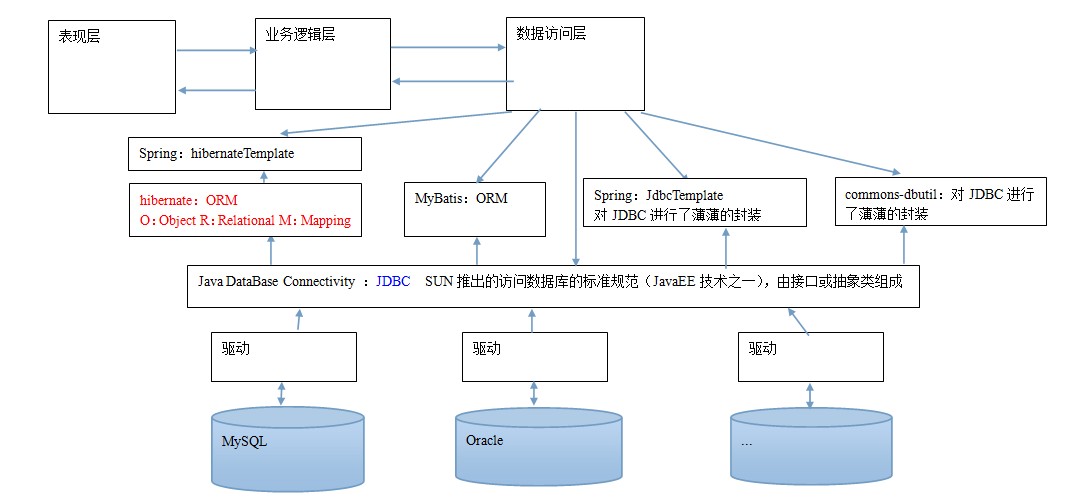
它是 spring 框架中提供的一个对象,是对原始 Jdbc API 对象的简单封装。spring 框架为我们提供了很多
的操作模板类。
操作关系型数据的:
JdbcTemplate
HibernateTemplate
操作 nosql 数据库的:
RedisTemplate
操作消息队列的:
JmsTemplate
我们今天的主角在 spring-jdbc-5.0.2.RELEASE.jar 中,我们在导包的时候,除了要导入这个 jar 包
外,还需要导入一个 spring-tx-5.0.2.RELEASE.jar(它是和事务相关的)。
<?xml version="1.0" encoding="UTF-8"?>
<beans xmlns="http://www.springframework.org/schema/beans"
xmlns:xsi="http://www.w3.org/2001/XMLSchema-instance"
xsi:schemaLocation="http://www.springframework.org/schema/beans
http://www.springframework.org/schema/beans/spring-beans.xsd">
<!-- 配置账户的持久层-->
<bean id="accountDao" class="com.itheima.dao.impl.AccountDaoImpl">
<!--<property name="jdbcTemplate" ref="jdbcTemplate"></property>-->
<property name="dataSource" ref="dataSource"></property>
</bean>
<!--配置JdbcTemplate
<bean id="jdbcTemplate" class="org.springframework.jdbc.core.JdbcTemplate">
<property name="dataSource" ref="dataSource"></property>
</bean>-->
<!-- 配置数据源-->
<bean id="dataSource" class="org.springframework.jdbc.datasource.DriverManagerDataSource">
<property name="driverClassName" value="com.mysql.jdbc.Driver"></property>
<property name="url" value="jdbc:mysql://118.24.175.34:3306/java_test"></property>
<property name="username" value="root"></property>
<property name="password" value="p@ssw0rd"></property>
</bean>
</beans>
//继承jdbcdaosupport
package com.itheima.dao.impl;
import com.itheima.dao.IAccountDao;
import com.itheima.domain.Account;
import org.springframework.jdbc.core.BeanPropertyRowMapper;
import org.springframework.jdbc.core.support.JdbcDaoSupport;
import java.util.List;
/**
* 账户的持久层实现类
*/
public class AccountDaoImpl extends JdbcDaoSupport implements IAccountDao {
@Override
public Account findAccountById(Integer accountId) {
List<Account> accounts = super.getJdbcTemplate().query("select * from account where id = ?",new BeanPropertyRowMapper<Account>(Account.class),accountId);
return accounts.isEmpty()?null:accounts.get(0);
}
@Override
public Account findAccountByName(String accountName) {
List<Account> accounts = super.getJdbcTemplate().query("select * from account where name = ?",new BeanPropertyRowMapper<Account>(Account.class),accountName);
if(accounts.isEmpty()){
return null;
}
if(accounts.size()>1){
throw new RuntimeException("结果集不唯一");
}
return accounts.get(0);
}
@Override
public void updateAccount(Account account) {
super.getJdbcTemplate().update("update account set name=?,money=? where id=?",account.getName(),account.getMoney(),account.getId());
}
}
//不继承
package com.itheima.dao.impl;
import com.itheima.dao.IAccountDao;
import com.itheima.domain.Account;
import org.springframework.beans.factory.annotation.Autowired;
import org.springframework.jdbc.core.BeanPropertyRowMapper;
import org.springframework.jdbc.core.JdbcTemplate;
import org.springframework.stereotype.Repository;
import java.util.List;
/**
* 账户的持久层实现类
*/
@Repository
public class AccountDaoImpl2 implements IAccountDao {
@Autowired
private JdbcTemplate jdbcTemplate;
@Override
public Account findAccountById(Integer accountId) {
List<Account> accounts = jdbcTemplate.query("select * from account where id = ?",new BeanPropertyRowMapper<Account>(Account.class),accountId);
return accounts.isEmpty()?null:accounts.get(0);
}
@Override
public Account findAccountByName(String accountName) {
List<Account> accounts = jdbcTemplate.query("select * from account where name = ?",new BeanPropertyRowMapper<Account>(Account.class),accountName);
if(accounts.isEmpty()){
return null;
}
if(accounts.size()>1){
throw new RuntimeException("结果集不唯一");
}
return accounts.get(0);
}
@Override
public void updateAccount(Account account) {
jdbcTemplate.update("update account set name=?,money=? where id=?",account.getName(),account.getMoney(),account.getId());
}
}
public class JdbcTemplateDemo4 {
public static void main(String[] args) {
//1.获取容器
ApplicationContext ac = new ClassPathXmlApplicationContext("bean.xml");
//2.获取对象
IAccountDao accountDao = ac.getBean("accountDao",IAccountDao.class);
Account account = accountDao.findAccountById(1);
System.out.println(account);
account.setMoney(30000f);
accountDao.updateAccount(account);
}
}
事务管理

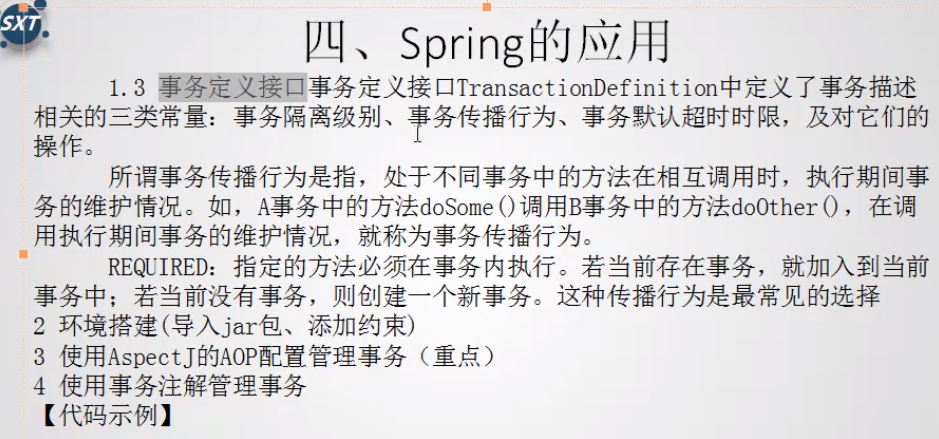
xml
<?xml version="1.0" encoding="UTF-8"?>
<beans xmlns="http://www.springframework.org/schema/beans"
xmlns:xsi="http://www.w3.org/2001/XMLSchema-instance"
xmlns:aop="http://www.springframework.org/schema/aop"
xmlns:tx="http://www.springframework.org/schema/tx"
xsi:schemaLocation="
http://www.springframework.org/schema/beans
http://www.springframework.org/schema/beans/spring-beans.xsd
http://www.springframework.org/schema/tx
http://www.springframework.org/schema/tx/spring-tx.xsd
http://www.springframework.org/schema/aop
http://www.springframework.org/schema/aop/spring-aop.xsd">
<!-- 配置业务层-->
<bean id="accountService" class="com.itheima.service.impl.AccountServiceImpl">
<property name="accountDao" ref="accountDao"></property>
</bean>
<!-- 配置账户的持久层-->
<bean id="accountDao" class="com.itheima.dao.impl.AccountDaoImpl">
<property name="dataSource" ref="dataSource"></property>
</bean>
<!-- 配置数据源-->
<bean id="dataSource" class="org.springframework.jdbc.datasource.DriverManagerDataSource">
<property name="driverClassName" value="com.mysql.jdbc.Driver"></property>
<property name="url" value="jdbc:mysql://localhost:3306/eesy"></property>
<property name="username" value="root"></property>
<property name="password" value="1234"></property>
</bean>
<!-- spring中基于XML的声明式事务控制配置步骤
1、配置事务管理器
2、配置事务的通知
此时我们需要导入事务的约束 tx名称空间和约束,同时也需要aop的
使用tx:advice标签配置事务通知
属性:
id:给事务通知起一个唯一标识
transaction-manager:给事务通知提供一个事务管理器引用
3、配置AOP中的通用切入点表达式
4、建立事务通知和切入点表达式的对应关系
5、配置事务的属性
是在事务的通知tx:advice标签的内部
-->
<!-- 配置事务管理器 -->
<bean id="transactionManager" class="org.springframework.jdbc.datasource.DataSourceTransactionManager">
<property name="dataSource" ref="dataSource"></property>
</bean>
<!-- 配置事务的通知-->
<tx:advice id="txAdvice" transaction-manager="transactionManager">
<!-- 配置事务的属性
isolation:用于指定事务的隔离级别。默认值是DEFAULT,表示使用数据库的默认隔离级别。
propagation:用于指定事务的传播行为。默认值是REQUIRED,表示一定会有事务,增删改的选择。查询方法可以选择SUPPORTS。
read-only:用于指定事务是否只读。只有查询方法才能设置为true。默认值是false,表示读写。
timeout:用于指定事务的超时时间,默认值是-1,表示永不超时。如果指定了数值,以秒为单位。
rollback-for:用于指定一个异常,当产生该异常时,事务回滚,产生其他异常时,事务不回滚。没有默认值。表示任何异常都回滚。
no-rollback-for:用于指定一个异常,当产生该异常时,事务不回滚,产生其他异常时事务回滚。没有默认值。表示任何异常都回滚。
-->
<tx:attributes>
<tx:method name="*" propagation="REQUIRED" read-only="false"/>
<tx:method name="find*" propagation="SUPPORTS" read-only="true"></tx:method>
</tx:attributes>
</tx:advice>
<!-- 配置aop-->
<aop:config>
<!-- 配置切入点表达式-->
<aop:pointcut id="pt1" expression="execution(* com.itheima.service.impl.*.*(..))"></aop:pointcut>
<!--建立切入点表达式和事务通知的对应关系 -->
<aop:advisor advice-ref="txAdvice" pointcut-ref="pt1"></aop:advisor>
</aop:config>
</beans>
注解
package com.itheima.service.impl;
import com.itheima.dao.IAccountDao;
import com.itheima.domain.Account;
import com.itheima.service.IAccountService;
import org.springframework.beans.factory.annotation.Autowired;
import org.springframework.stereotype.Service;
import org.springframework.transaction.annotation.Propagation;
import org.springframework.transaction.annotation.Transactional;
/**
* 账户的业务层实现类
*
* 事务控制应该都是在业务层
*/
@Service("accountService")
@Transactional(propagation= Propagation.SUPPORTS,readOnly=true)//只读型事务的配置
public class AccountServiceImpl implements IAccountService{
@Autowired
private IAccountDao accountDao;
@Override
public Account findAccountById(Integer accountId) {
return accountDao.findAccountById(accountId);
}
//需要的是读写型事务配置
@Transactional(propagation= Propagation.REQUIRED,readOnly=false)
@Override
public void transfer(String sourceName, String targetName, Float money) {
System.out.println("transfer....");
//2.1根据名称查询转出账户
Account source = accountDao.findAccountByName(sourceName);
//2.2根据名称查询转入账户
Account target = accountDao.findAccountByName(targetName);
//2.3转出账户减钱
source.setMoney(source.getMoney()-money);
//2.4转入账户加钱
target.setMoney(target.getMoney()+money);
//2.5更新转出账户
accountDao.updateAccount(source);
int i=1/0;
//2.6更新转入账户
accountDao.updateAccount(target);
}
}
<?xml version="1.0" encoding="UTF-8"?>
<beans xmlns="http://www.springframework.org/schema/beans"
xmlns:xsi="http://www.w3.org/2001/XMLSchema-instance"
xmlns:aop="http://www.springframework.org/schema/aop"
xmlns:tx="http://www.springframework.org/schema/tx"
xmlns:context="http://www.springframework.org/schema/context"
xsi:schemaLocation="
http://www.springframework.org/schema/beans
http://www.springframework.org/schema/beans/spring-beans.xsd
http://www.springframework.org/schema/tx
http://www.springframework.org/schema/tx/spring-tx.xsd
http://www.springframework.org/schema/aop
http://www.springframework.org/schema/aop/spring-aop.xsd
http://www.springframework.org/schema/context
http://www.springframework.org/schema/context/spring-context.xsd">
<!-- 配置spring创建容器时要扫描的包-->
<context:component-scan base-package="com.itheima"></context:component-scan>
<!-- 配置JdbcTemplate-->
<bean id="jdbcTemplate" class="org.springframework.jdbc.core.JdbcTemplate">
<property name="dataSource" ref="dataSource"></property>
</bean>
<!-- 配置数据源-->
<bean id="dataSource" class="org.springframework.jdbc.datasource.DriverManagerDataSource">
<property name="driverClassName" value="com.mysql.jdbc.Driver"></property>
<property name="url" value="jdbc:mysql://localhost:3306/eesy"></property>
<property name="username" value="root"></property>
<property name="password" value="1234"></property>
</bean>
<!-- spring中基于注解 的声明式事务控制配置步骤
1、配置事务管理器
2、开启spring对注解事务的支持
3、在需要事务支持的地方使用@Transactional注解
-->
<!-- 配置事务管理器 -->
<bean id="transactionManager" class="org.springframework.jdbc.datasource.DataSourceTransactionManager">
<property name="dataSource" ref="dataSource"></property>
</bean>
<!-- 开启spring对注解事务的支持-->
<tx:annotation-driven transaction-manager="transactionManager"></tx:annotation-driven>
</beans>
bjsxt
package com.bjsxt.pojo;
//账户类
public class Account {
private Integer aid;
private String aname;
private double balance;
public Integer getAid() {
return aid;
}
public void setAid(Integer aid) {
this.aid = aid;
}
public String getAname() {
return aname;
}
public void setAname(String aname) {
this.aname = aname;
}
public double getBalance() {
return balance;
}
public void setBalance(double balance) {
this.balance = balance;
}
public Account() {
super();
// TODO Auto-generated constructor stub
}
public Account(String aname, double balance) {
super();
this.aname = aname;
this.balance = balance;
}
@Override
public String toString() {
return "Account [aid=" + aid + ", aname=" + aname + ", balance=" + balance + "]";
}
}
package com.bjsxt.pojo;
//基金类
public class Fund {
private Integer fid;
private String fname;
private int count;
public Integer getFid() {
return fid;
}
public void setFid(Integer fid) {
this.fid = fid;
}
public String getFname() {
return fname;
}
public void setFname(String fname) {
this.fname = fname;
}
public int getCount() {
return count;
}
public void setCount(int count) {
this.count = count;
}
public Fund() {
super();
// TODO Auto-generated constructor stub
}
public Fund(String fname, int count) {
super();
this.fname = fname;
this.count = count;
}
@Override
public String toString() {
return "Fund [fid=" + fid + ", fname=" + fname + ", count=" + count + "]";
}
}
package com.bjsxt.service;
import com.bjsxt.exceptions.FundException;
public interface FundService {
//开银行账户
void openAccount(String aname,double money);
//开基金账户
void openFund(String fname,int amount);
//购买基金
void buyFund(String aname,double money,String fname,int amount) throws FundException;
}
package com.bjsxt.service.impl;
import org.springframework.transaction.annotation.Transactional;
import com.bjsxt.dao.AccountDao;
import com.bjsxt.dao.FundDao;
import com.bjsxt.exceptions.FundException;
import com.bjsxt.service.FundService;
public class FundServiceImpl implements FundService {
private AccountDao accountDaoImpl;
private FundDao fundDaoImpl;
public AccountDao getAccountDaoImpl() {
return accountDaoImpl;
}
public void setAccountDaoImpl(AccountDao accountDaoImpl) {
this.accountDaoImpl = accountDaoImpl;
}
public FundDao getFundDaoImpl() {
return fundDaoImpl;
}
public void setFundDaoImpl(FundDao fundDaoImpl) {
this.fundDaoImpl = fundDaoImpl;
}
@Override
public void openAccount(String aname, double money) {
accountDaoImpl.insertAccount(aname, money);
}
@Override
public void openFund(String fname, int amount) {
fundDaoImpl.insertFund(fname, amount);
}
@Override
@Transactional(rollbackFor=FundException.class)
public void buyFund(String aname, double money, String fname, int amount) throws FundException {
accountDaoImpl.updateAccount(aname, money);
if (1==1) {
throw new FundException("购买基金出现异常!");
}
fundDaoImpl.updateFund(fname, amount);
}
}
package com.bjsxt.dao;
public interface FundDao {
//开基金账户
void insertFund(String fname,int amount);
//更新基金账户数量
void updateFund(String fname,int amount);
}
package com.bjsxt.dao;
public interface AccountDao {
//开银行账户
void insertAccount(String aname,double money);
//更新银行账户余额
void updateAccount(String aname,double money);
}
package com.bjsxt.dao.impl;
import org.springframework.jdbc.core.support.JdbcDaoSupport;
import com.bjsxt.dao.FundDao;
public class FundDaoImpl extends JdbcDaoSupport implements FundDao {
//开基金账户
@Override
public void insertFund(String fname, int amount) {
String sql="insert into fund(fname,count) values(?,?)";
this.getJdbcTemplate().update(sql, fname,amount);
}
//更新基金账户
@Override
public void updateFund(String fname, int amount) {
String sql="update fund set count=count+? where fname=?";
this.getJdbcTemplate().update(sql, amount,fname);
}
}
package com.bjsxt.dao.impl;
import org.springframework.jdbc.core.support.JdbcDaoSupport;
import com.bjsxt.dao.AccountDao;
public class AccountDaoImpl extends JdbcDaoSupport implements AccountDao {
//开银行账户
@Override
public void insertAccount(String aname, double money) {
String sql ="insert into account(aname,balance) values(?,?)";
this.getJdbcTemplate().update(sql, aname,money);
}
//更新银行账户
@Override
public void updateAccount(String aname, double money) {
String sql="update account set balance=balance-? where aname=?";
this.getJdbcTemplate().update(sql, money,aname);
}
}
package com.bjsxt.exceptions;
public class FundException extends Exception{
public FundException() {
super();
}
public FundException(String message) {
super(message);
}
}
<?xml version="1.0" encoding="UTF-8"?>
<beans xmlns="http://www.springframework.org/schema/beans"
xmlns:xsi="http://www.w3.org/2001/XMLSchema-instance"
xmlns:context="http://www.springframework.org/schema/context"
xmlns:aop="http://www.springframework.org/schema/aop"
xmlns:tx="http://www.springframework.org/schema/tx"
xsi:schemaLocation="http://www.springframework.org/schema/beans
http://www.springframework.org/schema/beans/spring-beans.xsd
http://www.springframework.org/schema/aop
http://www.springframework.org/schema/aop/spring-aop.xsd
http://www.springframework.org/schema/tx
http://www.springframework.org/schema/tx/spring-tx.xsd
http://www.springframework.org/schema/context
http://www.springframework.org/schema/context/spring-context.xsd">
<!-- 加载jdbc属性文件 -->
<context:property-placeholder location="jdbc.properties"/>
<!-- 注册c3p0数据源 -->
<bean id="dataSource" class="com.mchange.v2.c3p0.ComboPooledDataSource">
<property name="driverClass" value="${jdbc.driver}"/>
<property name="jdbcUrl" value="${jdbc.url}"/>
<property name="user" value="${jdbc.username}"/>
<property name="password" value="${jdbc.password}"/>
</bean>
<!-- 注册accountDao -->
<bean id="accountDaoImpl" class="com.bjsxt.dao.impl.AccountDaoImpl">
<property name="dataSource" ref="dataSource"></property>
</bean>
<!-- 注册fundDao -->
<bean id="fundDaoImpl" class="com.bjsxt.dao.impl.FundDaoImpl">
<property name="dataSource" ref="dataSource"></property>
</bean>
<!-- 注册service -->
<bean id="fundServiceImpl" class="com.bjsxt.service.impl.FundServiceImpl">
<property name="accountDaoImpl" ref="accountDaoImpl"></property>
<property name="fundDaoImpl" ref="fundDaoImpl"></property>
</bean>
<!-- 注册事务管理器 -->
<bean id="transactionManager" class="org.springframework.jdbc.datasource.DataSourceTransactionManager">
<property name="dataSource" ref="dataSource"></property>
</bean>
<!-- aop配置事务
<tx:advice id="txAdvice" transaction-manager="transactionManager">
<tx:attributes>
<tx:method name="open*" isolation="DEFAULT" propagation="REQUIRED"/>
<tx:method name="buy*" isolation="DEFAULT" propagation="REQUIRED" rollback-for="FundException"/>
</tx:attributes>
</tx:advice>
<aop:config>
<aop:pointcut expression="execution(* *..service.*.buyFund(..))" id="fundPC"/>
<aop:advisor advice-ref="txAdvice" pointcut-ref="fundPC"/>
</aop:config>
-->
<!-- 配置事务注解驱动 -->
<tx:annotation-driven transaction-manager="transactionManager"/>
</beans>
jdbc.driver=com.mysql.jdbc.Driver
jdbc.url=jdbc:mysql://118.24.175.34:3306/java_test
jdbc.username=root
jdbc.password=p@ssw0rd
纯注解
package config;
import org.springframework.context.annotation.ComponentScan;
import org.springframework.context.annotation.Configuration;
import org.springframework.context.annotation.Import;
import org.springframework.context.annotation.PropertySource;
import org.springframework.transaction.annotation.EnableTransactionManagement;
/**
* spring的配置类,相当于bean.xml
*/
@Configuration
@ComponentScan("com.itheima")
@Import({JdbcConfig.class,TransactionConfig.class})
@PropertySource("jdbcConfig.properties")
@EnableTransactionManagement
public class SpringConfiguration {
}
package config;
import org.springframework.beans.factory.annotation.Value;
import org.springframework.context.annotation.Bean;
import org.springframework.jdbc.core.JdbcTemplate;
import org.springframework.jdbc.datasource.DriverManagerDataSource;
import javax.sql.DataSource;
/**
* 和连接数据库相关的配置类
*/
public class JdbcConfig {
@Value("${jdbc.driver}")
private String driver;
@Value("${jdbc.url}")
private String url;
@Value("${jdbc.username}")
private String username;
@Value("${jdbc.password}")
private String password;
/**
* 创建JdbcTemplate
* @param dataSource
* @return
*/
@Bean(name="jdbcTemplate")
public JdbcTemplate createJdbcTemplate(DataSource dataSource){
return new JdbcTemplate(dataSource);
}
/**
* 创建数据源对象
* @return
*/
@Bean(name="dataSource")
public DataSource createDataSource(){
DriverManagerDataSource ds = new DriverManagerDataSource();
ds.setDriverClassName(driver);
ds.setUrl(url);
ds.setUsername(username);
ds.setPassword(password);
return ds;
}
}
package config;
import org.springframework.context.annotation.Bean;
import org.springframework.jdbc.datasource.DataSourceTransactionManager;
import org.springframework.transaction.PlatformTransactionManager;
import javax.sql.DataSource;
/**
* 和事务相关的配置类
*/
public class TransactionConfig {
/**
* 用于创建事务管理器对象
* @param dataSource
* @return
*/
@Bean(name="transactionManager")
public PlatformTransactionManager createTransactionManager(DataSource dataSource){
return new DataSourceTransactionManager(dataSource);
}
}
jdbc.driver=com.mysql.jdbc.Driver
jdbc.url=jdbc:mysql://118.24.175.34:3306/java_test
jdbc.username=root
jdbc.password=p@ssw0rd
package com.itheima.test;
import com.itheima.service.IAccountService;
import config.SpringConfiguration;
import org.junit.Test;
import org.junit.runner.RunWith;
import org.springframework.beans.factory.annotation.Autowired;
import org.springframework.test.context.ContextConfiguration;
import org.springframework.test.context.junit4.SpringJUnit4ClassRunner;
/**
* 使用Junit单元测试:测试我们的配置
*/
@RunWith(SpringJUnit4ClassRunner.class)
@ContextConfiguration(classes= SpringConfiguration.class)
public class AccountServiceTest {
@Autowired
private IAccountService as;
@Test
public void testTransfer(){
as.transfer("aaa","bbb",100f);
}
}

